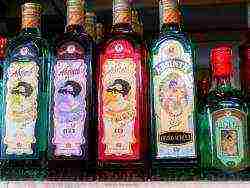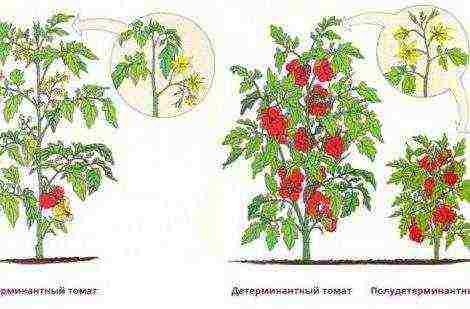Content

Let's talk about cherries and describe the best varieties of it. There are sweet, slightly sour, crispy, soft, different colors. Thanks to selection, every year new forms of this amazing tree are bred.
Cherry varieties: description and photo
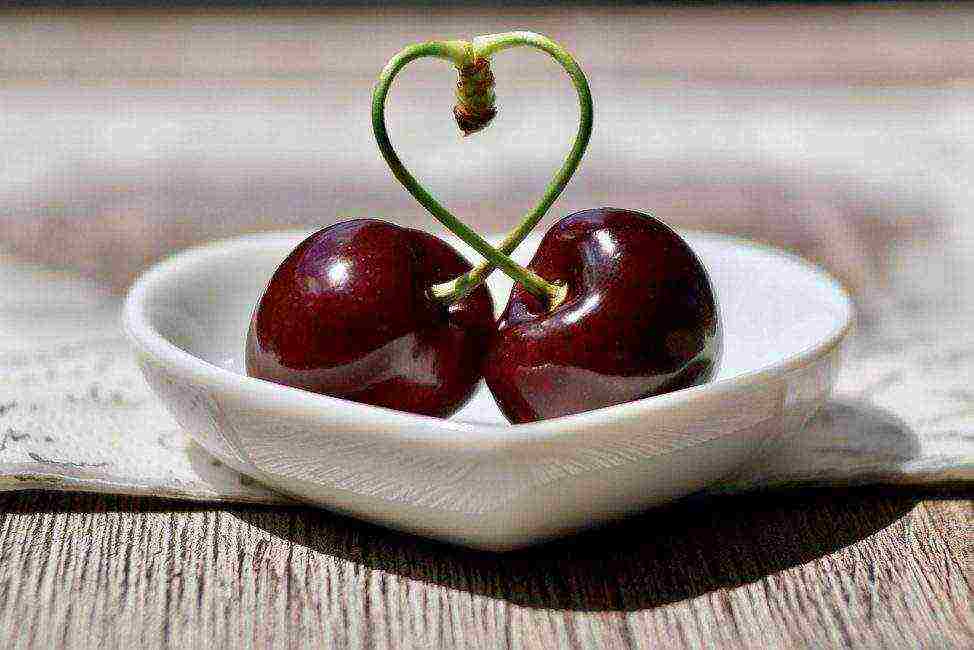
To get a bountiful harvest, it is necessary to choose varieties taking into account the peculiarities of the climate in a particular region. So, frost-resistant varieties are suitable for central Russia, and more thermophilic plants can be grown in Ukraine.
Unlike cherry, sweet cherry ripens much earlier, its tasty and aromatic fruits can already be enjoyed in early summer - June. It is a real source of useful trace elements (iron, iodine, potassium, magnesium, calcium) The fruits of the plant grow in the form of a single-celled drupe with a juicy pericarp.
Taking into account the late period of emergence of cherry fruit buds from the state of forced dormancy, the yield of this crop is characterized as stable. Another advantage of cherries is the presence of reliable protection from return frost in anthers and pistils, which is not the case with cherries.
The leaves of the fruit crop are very large in size, they are distinguished by an elongated-oval or elongated-obovate shape and brown glands on the petioles.
Most of the cherry varieties require additional pollination. Therefore, when choosing a tree, it is recommended to study its description, which indicates the necessary pollinators.
It is not so often possible to find self-fertile varieties on the market. They can be purchased by order from abroad. Among the popular hybrid forms, there are: Alex, Peter, Stella, Sandor, Sweet Hart.
Below is a list of the most popular cherry varieties with descriptions and photos.
Iput
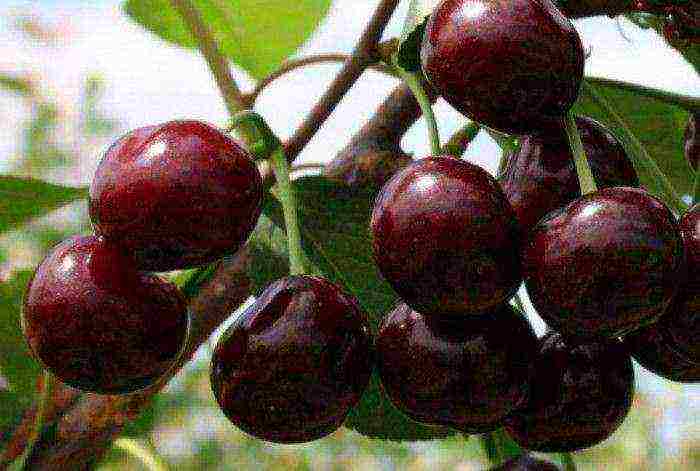
Read also:Everything about planting and growing cherries - from choosing a seedling to harvesting (Photo & Video) + Reviews
PROS:
- Average height
- Early ripening of fruits
- High yield (up to 30 kg of berries are removed from one tree)
- High palatability (fruits have black color and dark red juicy pulp)
- The berry is removed with the stalk
- The crop is not afraid of transportation
- High degree of resistance to fungal infections
- It tolerates low temperatures well (up to -28 degrees)
MINUSES:
- Average early maturity (yields a harvest 5 years after planting)
- With an excess of moisture, the fruits crack
- The pulp is difficult to separate from the bone
According to reviews:
It is recommended to plant it in pairs together with Revna, since these varieties are inter-pollinated. It turned out to be very tasty, large, the first harvest is already 3 years old. It grows quickly, almost one-meter increments per year. turned out to be not dark red, but just red, maybe because of the lack of the sun.
Valery Chkalov

PROS:
- Early ripening of berries
- Large fruit size (weight up to 6-8 g)
- High taste characteristics of fruits (the pulp is dark red in color, juicy, semi-gristly consistency)
- Dessert type
- Universal use of berries
- High level of productivity (62 kg per tree on average)
- High level of frost resistance (-23.5 degrees
MINUSES:
- Height (up to 5 m)
- Wet separation of the berry from the stalk, juice is released
- The level of early maturity is medium (yields a harvest for 5 years)
- Self-infertile variety
- Average level of resistance to diseases, including fungal
Pollinators: Dnieper, Bigarro Burlat, April, June early Skorospelka
Jealous
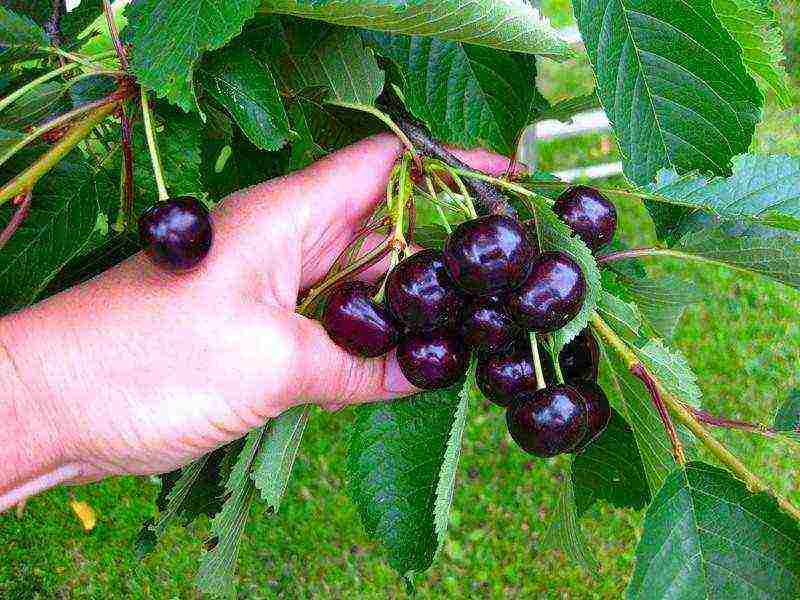
Read also:Cherries: what you need to know about them in order to receive generous harvests. Description, planting and care (25 Photos & Videos) + Reviews
PROS:
- Medium-sized tree, compact
- The crown has no sharp forks
- Unpretentious in care
- Fruits are distinguished by high taste and consumer qualities.
- Due to the dense skin, the crop is transportable over long distances
- High level of frost resistance (up to -30 degrees)
- High resistance to frost crack, sunburn
- Resistance of the tree to fungal infections
MINUSES:
- Medium late harvest ripening
- Self-infertility
Its best pollinators: Raditsy, Compact, Iput, Venyaminova, Tyutchevka, Ovstuzhenki
Large-fruited
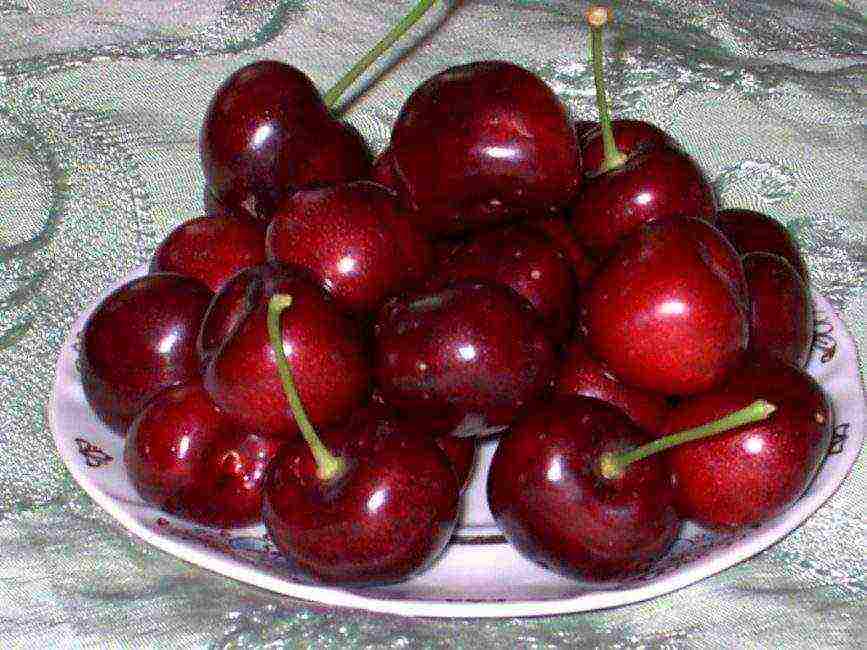
PROS:
- Medium-sized tree
- Fruits are very large in size, their weight is up to 18 g
- Sweet and sour taste, dark red fruit color, medium density pulp
- High product characteristics
- Increased frost resistance
- Dry detachment of the peduncle
- Good transportability
- Not susceptible to moniliosis
- Drought tolerance, no loss of crop flavor
MINUSES:
- Late ripening
- Self-sterile
Top pollinators: Bugaro Oratovsky, Surprise, Francis,
Vasilisa

PROS:
- Mid-season
- Very large berries, weighing up to 15 g
- Taste and commercial qualities are excellent (the fruits have a rich red color, glossy shine, the pulp is dense, fleshy, juicy)
- Tasting score 4.5 points
- Duration of fruiting 20 years
MINUSES:
- Berries with heavy precipitation are subject to shedding
- Requires additional pollination
- Low resistance to fungal diseases and garden pests
Top pollinators: Early ripening, Burlat, April, Household, Early Bigarro
Ovstuzhenka
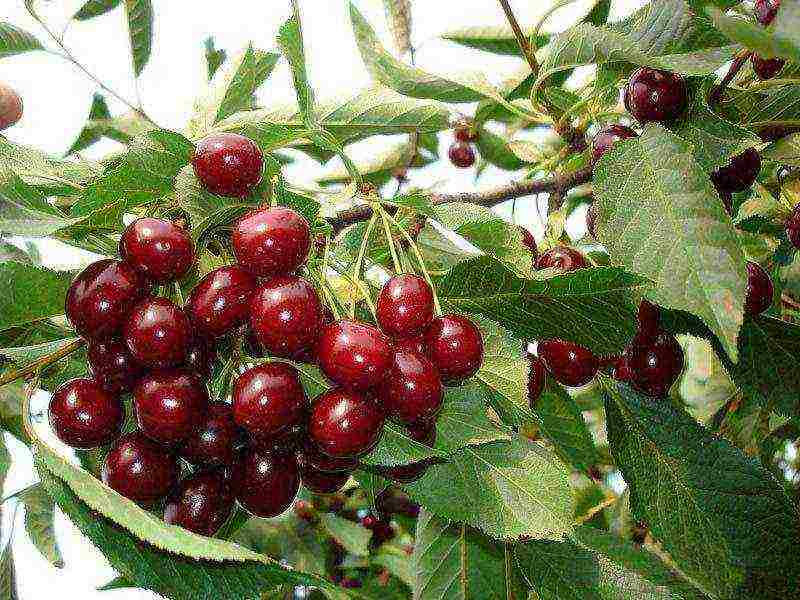
PROS:
- Early ripening of the crop
- It does not require special care
- Medium-sized tree, with a rapid growth rate
- Large berries, weight up to 7 g
- The pulp is sweet enough, juicy
- The color of the berries is dark burgundy
- Product and taste characteristics are high
- Disease resistance is good
- High frost resistance
MINUSES:
- Average yield, on average 15 kg per tree
Regina
PROS:
- Late-ripening variety
- The size of the tree is medium, the growth is gradual
- Does not create difficulties in care and harvesting
- High indicator of presentation and taste
- Berries are not afraid of transportation
- The structure of the berries is firm, the pulp is tasty and aromatic
- The size of the fruits is large, their weight reaches 10 g
- The level of frost resistance is sufficient
- Disease resistance to garden pests is excellent
MINUSES:
- Low rate of resistance to viral diseases
- Requires additional pollination
Pollinators: Karina, Bianca, Sylvia, Nephris, Coral Lotivka
Bull heart

PROS:
- Large-fruited, average berry size 8 g
- The color of the fruit is dark burgundy, the pulp is medium density, the skin is moderately dense with a smooth surface
- Type of separation from the stalk dry
- Universal purpose of fruits
- High degree of productivity
- The size of the tree is medium, but there are also tall plants.
- The degree of frost resistance is good, up to - 25 degrees
- Not susceptible to coccomycosis
MINUSES:
- Low transport rate despite dense skin
- Berries have a short shelf life, processing is required as soon as possible
- Self-infertile variety
Top pollinators: Tyutchevka, Iput, Ovstuzhenka
Yellow
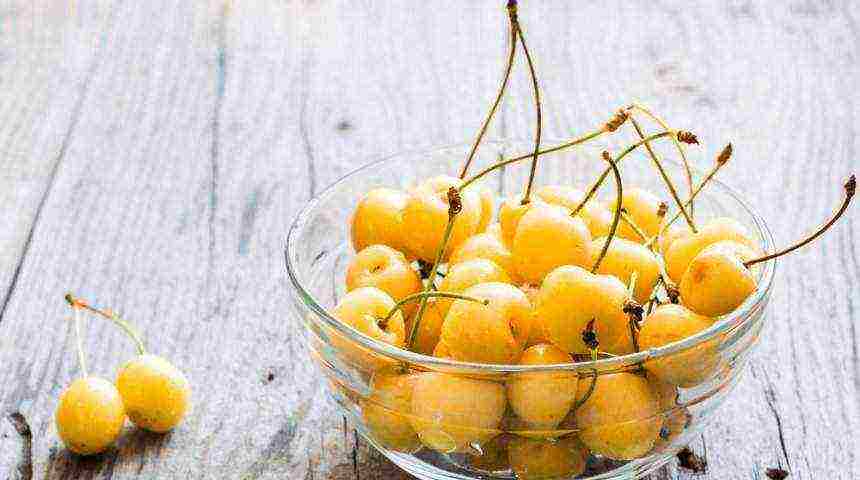
PROS:
- Late ripening of berries
- Increased winter hardiness
- Excellent taste (the pulp is amber, dense structure, juiciness and pronounced aroma)
MINUSES:
- The degree of transportability is low
- The pulp does not separate well from the bone
- Additional pollination required
- Exposed to the invasion of the cherry fly
Pollinators: Bagration, Napoleon pink. Denissena yellow, Cassini early
Early pink
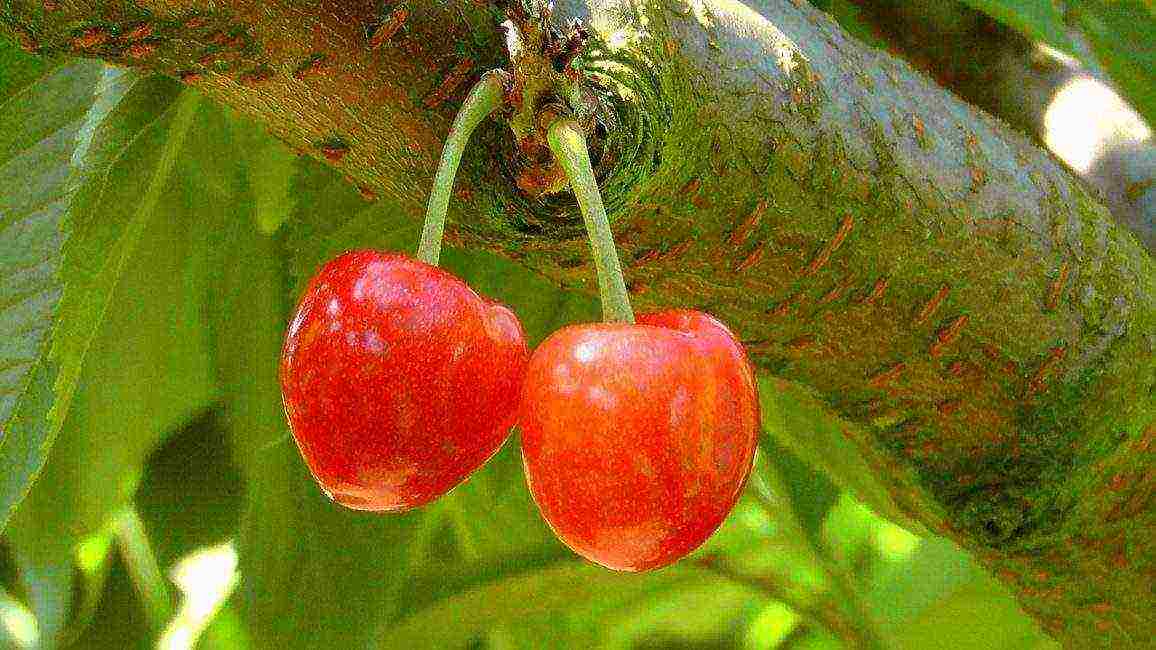
PROS:
- Early ripeness of fruits
- Taste characteristics are high (the pulp is distinguished by a creamy color, the structure is medium-dense, the juice is transparent)
- High resistance to low temperatures
- A fairly good level of resistance to monoliosis, coccomycosis
- Dessert type of berries
- High yield rate, up to 40 kg per tree on average
MINUSES:
- Berries are medium in size, their weight reaches an average of 5 g
- Trees grow up to 5 m
- Low rate of crop transportability
- Poor keeping quality of berries, processing is required in a short time after full ripening
Fatezh
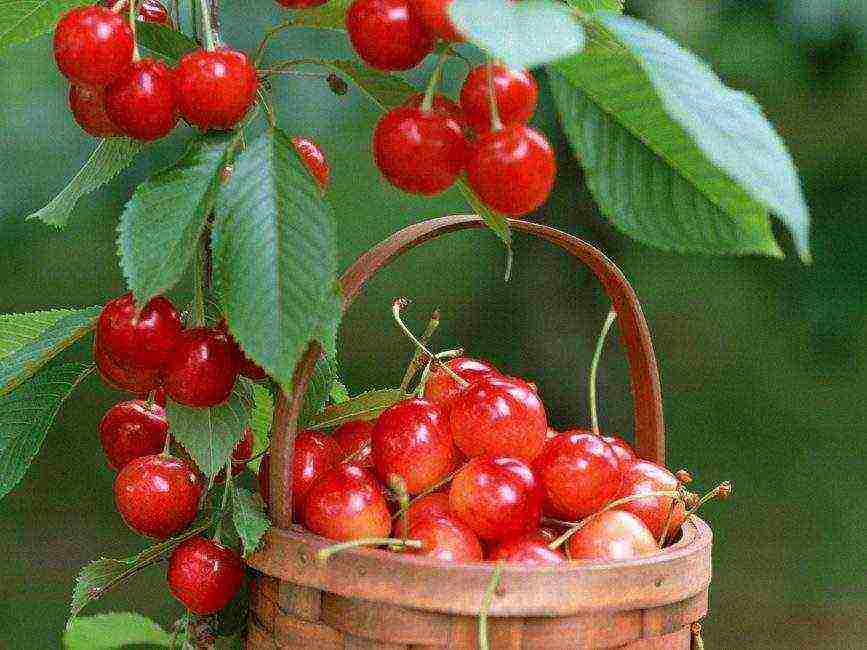
PROS:
- Large-fruited, their average weight is 4.5 g, maximum 6 g
- Fruit tasting score 4.7 points
- The pulp separates easily from the bone
- Fruiting begins at 3-4 years of life of the tree
- The yield indicator reaches 50 kg per tree per season
- The level of winter hardiness is high -30 degrees
- Not susceptible to fungal infections, coccomycosis, moniliosis
- Berries are not afraid of long-distance transportation
MINUSES:
- Additional pollination required
Recommended pollinators: Chermashnaya, Iput, Revna, Crimean, Raditsa.
Leningrad black
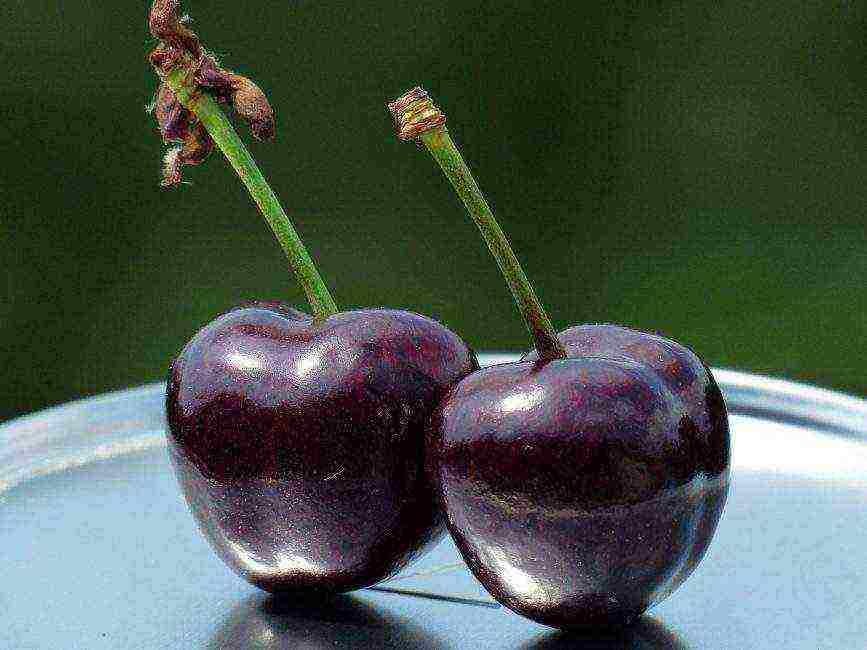
PROS:
- The variety is medium-sized, the crown is spreading
- The first crop can be harvested in the third year after planting in a permanent place, in June
- Tasting assessment of the harvest 4.2 points
- Taste and commercial characteristics are high (the average weight of berries is 5 g, the color is dark burgundy, the pulp is sweet, juicy, there is a slight bitterness)
- The purpose of the fruits is universal, excellent for fresh consumption, and for compotes, jam
- High rate of resistance to garden pests and various diseases
- The variety is unpretentious in care
- The increased degree of frost resistance, withstands low temperatures up to -30 degrees
MINUSES:
- Self-fertile variety
- Additional pollination required
Pollinators required: Leningrad yellow, Leningrad pink, Red dense, Fatezh Berries are prone to cracking, with excessive moisture.
Dybera black
PROS:
- A high level of productivity, most often up to 90 kg of tasty and aromatic berries are removed from trees, but under favorable conditions, 170 kg of harvest can be removed from one tree
- Fruits are large in size, their average weight is 6 g
- The pulp is of medium density, juiciness, dark burgundy color, there is a slight sourness
- The frost resistance index is quite high, up to -30 degrees
MINUSES:
- Poor resistance to negative temperatures
- Mature trees reach a height of almost 6 m, which makes them difficult to care for and harvest
- The tree begins to bear fruit 5 years after planting in a permanent place
- Requires additional pollination
- Insufficient immunity to various types of diseases, including fungal, to garden pests
- Regular pruning of the crown is required
Recommended pollinators: Drogana yellow, Bull heart, Napoleon pink, Fatezh,
Cordia
PROS:
- "Queen" of late varieties
- Universal fruits
- Taste and commercial characteristics are high
- Berries are large enough, their weight can reach 8-10 g
- Color carmine black, skin tone bronze
- Fruits are not prone to cracking, do not rot
- Excellent long-distance transportation
- When grown on vigorous rootstocks, it grows rapidly
- Productivity is regular, fairly high
MINUSES:
- The variety is self-fertile, additional pollination is required
- There is a need for short pruning, the growth of shoots is significantly enhanced
- Average winter hardiness
- The crop is moderately resistant to cracking
Top pollinators: Van, Summit, Karina, Regina, Burlat.
Tyutchevka
PROS:
- Medium late harvest ripening
- Medium-sized tree, semi-spreading crown, sparse, spherical
- The beginning of the fruiting period falls on 3-4 years of plant life.
- The berries are medium in size, their weight is 5-6 g, but under favorable growing conditions they can reach 7 g
- Taste and commercial characteristics are excellent (the color of the pulp is dark red, the structure is dense, the aroma is pronounced)
- Tasting assessment of the harvest 4.9 points
- The crop is not afraid of transportation over long distances, the keeping quality of the fruits is good
- Resistance to major diseases is good
- The average productivity index is over 97 c / ha, with proper agricultural technology this indicator can reach 275 c / ha
- High level of resistance to moniliosis
MINUSES:
- Low self-pollination rate, up to 6%
- Average degree of resistance to clasterosporium disease, coccomycosis
Top pollinators: Iput, Raditsa, Revna, Ovstuzhenka
General's
PROS:
- Variety with medium-late ripening of berries
- The size of the fruits is large enough, their weight is 9-12 g
- The color is yellow, there is a carmine blush
- The pulp stands out with a sweet and sour taste, dense structure, very juicy
- Tasting score - 4.6 points
- The indicator of drought resistance and frost resistance is very high
- Fruiting begins 3 years after planting in a permanent place
- Unpretentiousness when growing
- Resistance to typical diseases and garden pests is sufficient
MINUSES:
- Fruits cannot retain their taste and marketability for a long time, they do not tolerate long-distance transportation
Pollinators: Tyutchevka, Ovstuzhenka, Iput, Crimean, Lapins
Italian

PROS:
- Self-fertile variety
- Fruits ripen early
- Taste and marketable qualities are excellent (the color of the berries is deep red, the pulp is moderately dense, tender, fleshy, it separates well from the stone)
- Large fruits, weight up to 6 g
- High productivity index
- Resistance to major diseases and garden pests is high
- Good frost resistance, up to - 28 degrees
MINUSES:
- There are no obvious shortcomings, based on the reviews of gardeners
Bakhor

PROS:
- The crop ripens early, in the first - in the second decade of May
- The tree grows very quickly, the leafiness is medium, the crown is round
- Fruiting period begins in the fourth year after planting in a permanent place.
- The size of the fruits is quite large, 8-9 g, their color is dark red, wide-heart shaped
- The color of the pulp is dark red, the structure is medium density, very juicy, it has a sweet taste, there is a slight sourness
- The pulp separates well from the stone
- Due to the dense skin, the crop is not afraid of transportation over long distances, it retains its presentation for a long time
- The fruits can be used both for fresh use and for compotes, jams, preserves.
- Tasting score 5 points
- Dessert type harvest
- Planting material is grown from seedlings
- The indicator of resistance to fungal diseases is good
- Frost resistance is sufficient, up to - 25 degrees
MINUSES:
- Vigorous, height 5-6 m
- The yield indicator is average, up to 45 kg of fruits can be removed from one tree
Farewell

PROS:
- Sweet cherry with an early ripening period, is very popular among gardeners and consumers.
- He is appreciated for its unpretentious care.
- Excellent taste of fruits, large-fruited, high rate of drought resistance and winter hardiness
- High yield rate, up to 95 kg of harvest is removed from one tree
- The fruits are excellent for fresh use, for winter harvesting
- The size of the berries is large enough, weight up to 13 g
- The color is red, the color of the flesh is yellow
- The taste is sweet, harmonious, the aroma is pronounced, there is a wine-sweet aftertaste
- The pulp is easily separated from the bone
- The tasting score is 4.5 points
- The variety is distinguished by its early maturity
- The yield is high, after 10 years the figure is about 100 kg
- Thanks to the dense skin, which protects the pulp well, the crop can be stored for a long time and is not afraid of transportation over long distances
- High degree of resistance to coccomycosis
- Increased degree of frost resistance
MINUSES:
- The tree is very vigorous, which makes it difficult to pick berries
- The variety is self-fertile, additional pollination is required.
- Average indicator of resistance to fungal infections
Pollinator varieties: Donetsk coal, Valery Chkalov, Donetsk beauty, Sister, Valeria, Donetsk Yaroslavna, Ethics, Rannnya rovinka, Aelita, Annushka, Donchanka
Yaroslavna
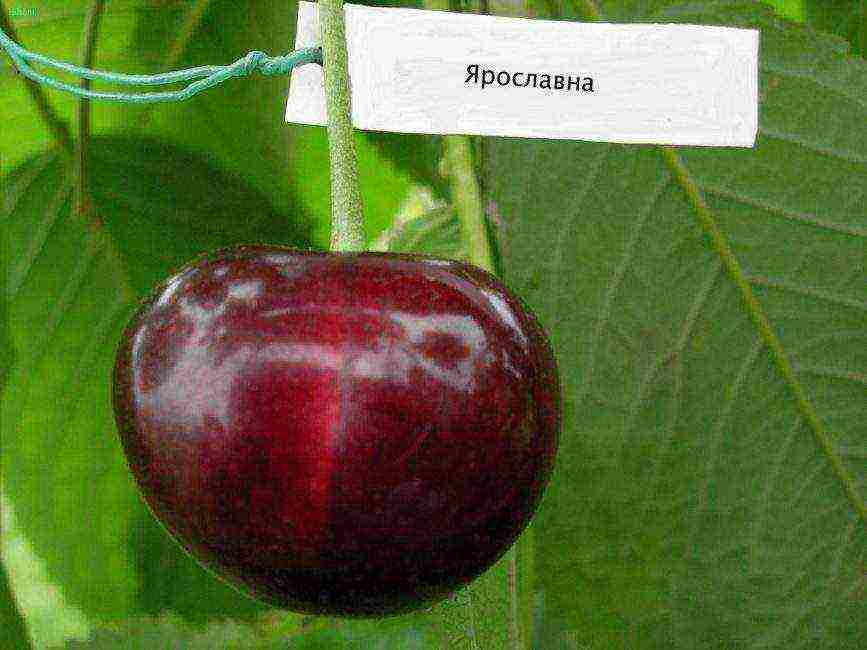
PROS:
- The tree is medium-sized, its height does not exceed 3.5 m
- Does not require special conditions for growing, care
- The yield indicator is high, annual
- Type of separation from the stalk dry
- Taste and marketable qualities are excellent
- Fruit size is large, weight is 8-9 g
- The pulp is very sweet, pleasant, of medium density, red in color
- The color of the cherry pomegranate is red, the stone is small in size, it separates well
- The increased degree of frost resistance, drought resistance, resistance to coccomycosis
- Berries in high humidity conditions do not crack
- Transportability is good
MINUSES:
- The variety is vigorous, the crown is spherical - spreading, the branches are curved
- Additional pollination required
- Average indicator of resistance to fungal infections
Pollinators: Ovstuzhenka, Raditsa, Iput, Chermashnaya, Fatezh.
7.5 Overall Score
After reviewing the description of cherry varieties, having studied their strengths and weaknesses, you can choose the most suitable option for your personal plot. It is recommended to purchase seedlings in specialized retail outlets, while you need to pay attention to the presence of damage on the trunk and root system. We tried to collect for you the most popular varieties of cherries and give all the necessary information on them. If you disagree with these ratings, leave your rating in the comments with the reasons for your choice. thank you for your participation. Your opinion will be useful to other users.
Add your review | Read reviews and comments
Sweet cherry is one of the most popular garden crops for growing on a personal plot. The yield and taste of berries largely depends on the choice of varieties for a particular region. Today, dozens of different varieties of this culture have been bred, with their own advantages and disadvantages. In the article we will consider the best varieties of cherries for central Russia, describe the features and photos of berries.
What to consider when choosing a cherry variety?
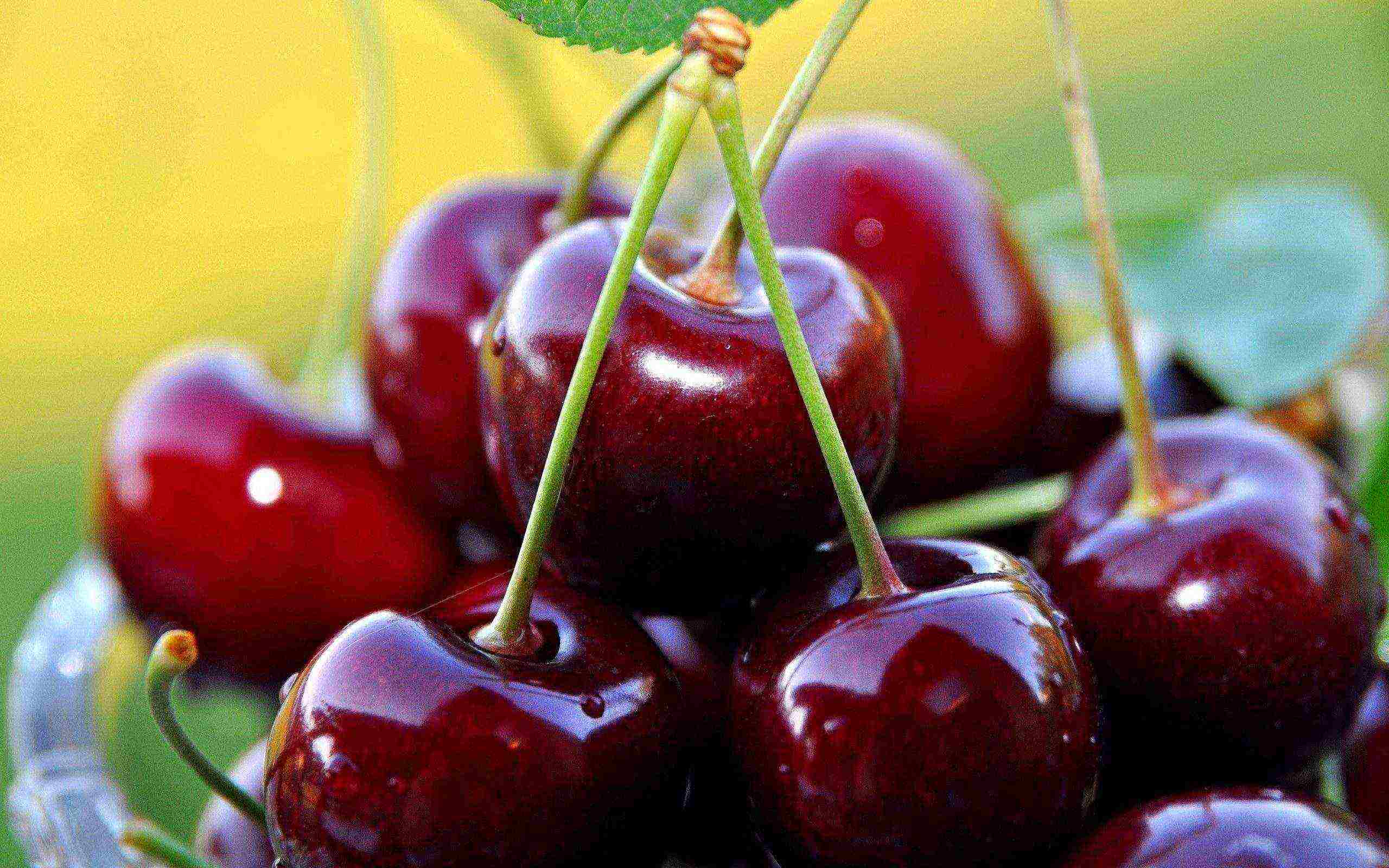
When choosing a cherry variety for central Russia, many factors must be considered:
- You should pay attention to winter hardiness. Sweet cherry is a thermophilic plant that can die during frosts. The higher the frost resistance of the variety, the better.
- It is advisable to purchase low-growing varieties - they have a more productive yield in an unfavorable climate, since most of the nutrients are spent on the formation of berries, and not on the crown.
- It is recommended to choose varieties that have a late flowering period - in conditions of middle latitudes, there is a prolonged spring and a late onset of stable high temperatures.
- Self-fertile varieties that do not need cross-pollination with other members of the species are best suited.
The best varieties
Breeders have bred several dozen varieties and hybrids of sweet cherries with different characteristics, productivity and adaptive abilities.Consider the descriptions of varieties for cultivation in the middle latitudes of Russia.
Iput
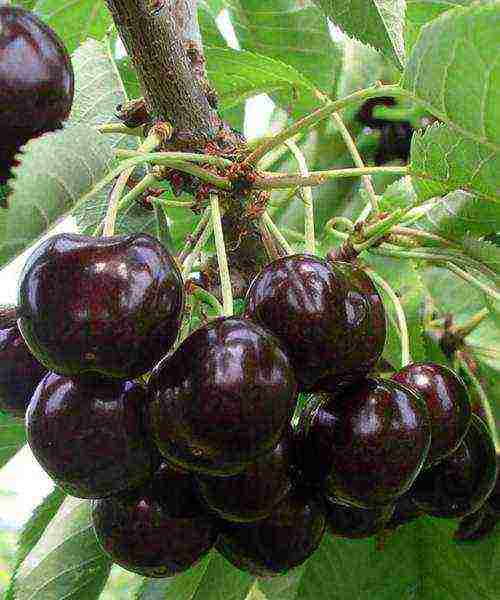
A fast-growing sweet cherry variety, bred by domestic breeders at the Research Institute of Lupine. It has been used for cultivation since 1993. The tree is medium-sized, reaching 4-5 meters in height.
The crown is dense, has a pyramidal shape, the leaves are elongated, elliptical with pronounced serration. The petioles are thick and short, on which there are 3-4 large flowers with white petals.
Flowering begins in May, the first harvest can be taken by mid-June. Fruits are large, blunt, heart-shaped, weighing up to 6.3 g. The skin is glossy, colored dark red. The pulp is juicy and tender, has a sweet dessert taste. The variety is versatile in application. Average productivity is 25-30 kg / tree.
The variety is winter-hardy, resistant to fungal diseases. Self-infertile type of pollination.
Jealous
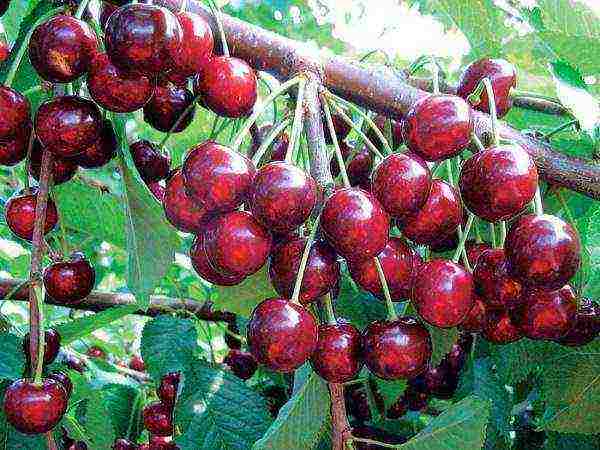
A mid-late variety bred at the Research Institute of Lupine by crossing seedlings of Bryanka pink cherry with other species. Recommended for cultivation in the Central Region.
Medium-sized trees with a pyramidal crown. Begins fruiting from 5 years. In spring, many ovoid leaves with jagged edges are formed on the shoots. The petiole has embossed veins and is colored brownish-pink. Flowering begins in mid-May, fruits ripen from early June. The variety is partially self-fertile, the proportion of self-pollination does not exceed 5%.
The fruits are of medium size, have a flat-round shape and an average weight of 4.7 g. The skin is very dense, dark red in color. The pulp is red in color, has a dense consistency and dessert taste, a medium-sized pit. The variety has high indicators of transportability.
Winter hardiness is above average, there is resistance to temperature extremes and sunburn. There is a high resistance to fungal diseases.
Fatezh
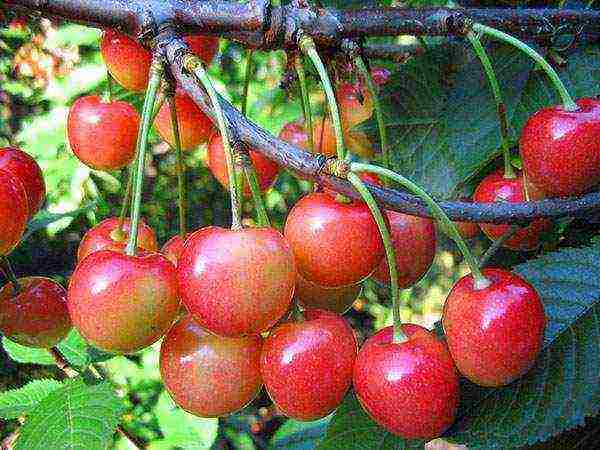
A mid-early variety bred at the All-Russian Institute of Selection and Technology by free pollination of Leningradskaya yellow sweet cherry. Listed in 2001, suitable for cultivation in the Central Region.
The trees are medium-sized with a height of up to 5 m. The crown is spherical, spreading and of medium density. The leaves are lanceolate, have finely serrated serration. White flowers, fruit ovaries are formed both on bouquet branches and annual shoots.
Flowering begins in late May, fruits are formed from the second decade of June. The berries are rounded, weighing up to 4.4 grams. The pulp is light yellow in color, with a juicy and dense structure. The stone is light, medium in size, well separated during processing. The taste is dessert type, has a sweet and sour aroma. The variety has a high yield - up to 30 kg / tree.
Winter hardiness is above average, there is no susceptibility to diseases. There is immunity to fungal diseases. The cultivar is self-fertile. The main disadvantage is the tendency to gum flow.
Tyutchevka
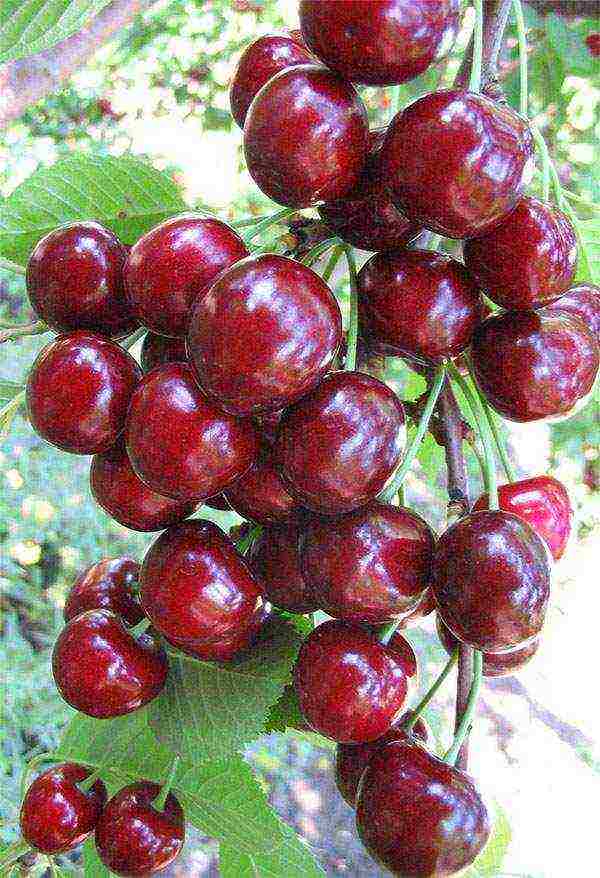
Late ripening variety, bred in 2001 at the Research Institute of Lupine by crossing Red dense cherry.
The tree is of medium height and fast growth rate. The crown is rare, spherical, depending on the place of cultivation, it can be spreading or semi-spreading. The leaves are large in size with a strongly pointed tip.
Fruiting occurs on bouquet branches. Flowering begins by mid-summer, fruiting by late July or early August.
Large fruits have a spherical shape and an average weight of 5.3 grams. The skin is dark red, small specks are acceptable. The pulp is red, with a dense and cartilaginous structure. The berries have a sweet taste with a high tasting rating. The maximum productivity occurs after 4-5 years of growth, the yield is up to 40 kg / tree.
It has a high level of winter hardiness and resistance to fungal diseases. The variety is sterile, the quality of self-pollination does not exceed 6%. The main disadvantage is the cracking of the fruit in humid climates.
Bryansk pink
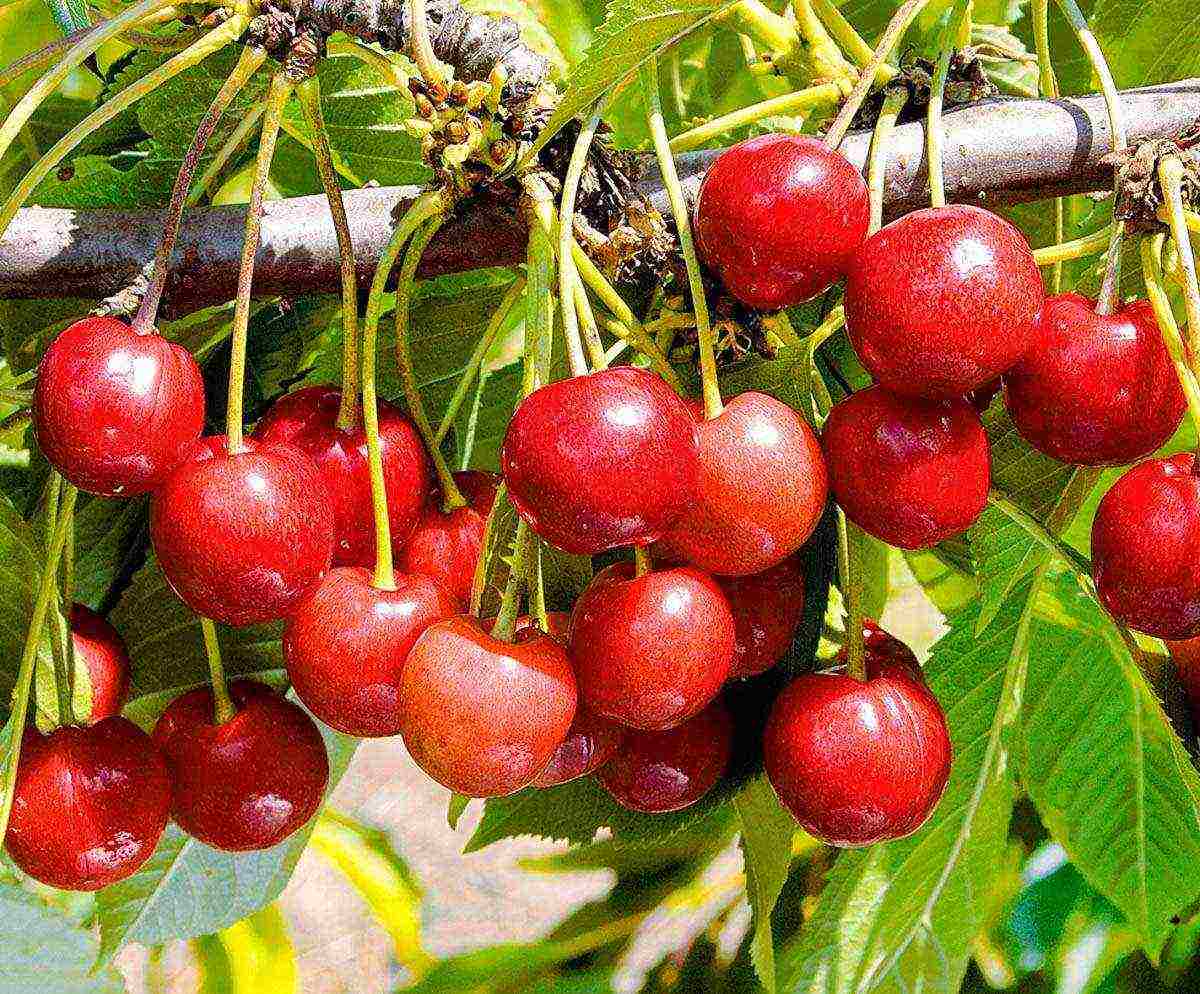
A late-ripening variety bred at the Research Institute of Lupine in 1987. Obtained on the basis of crossing cherry seedlings of the Black Muscat variety (Negritenok).
Sweet cherry is represented by a medium-sized tree with a raised pyramidal crown. The leaves are large, have a pointed top and a double-serrate serration. Fruits are formed on bouquet branches and annual shoots.
Flowering begins in mid-May, ripening of fruits - from the second decade of July to early August. Fruits are medium in size, round in shape. Average weight - 4.0 g. The skin is dense, pink-yellow in color. The pulp is of dense, cartilaginous consistency, with decent taste characteristics. The variety has universal application, the fruits tolerate transportation well. Productivity - up to 30 kg / tree.
The stem and base of the tree has high winter hardiness. There is a high immunity to fungal diseases of stone fruit crops. The variety is self-fertile, resistant to cracking.
Crimean
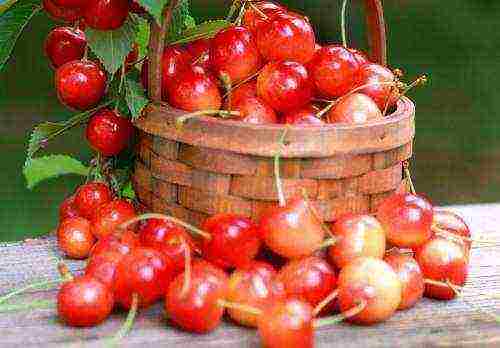
The variety was bred by domestic breeders in the Tula region, little is known about the history of its origin. In middle latitudes, it is used relatively rarely due to the presence of more productive crop varieties.
The tree reaches 3.5 m in height, is of medium size and spherical in shape. The berries ripen early, starting in mid-June. Fruits are small up to 2 g, have a dark red color. The pulp is juicy and tart, due to its specific taste it is often used for making wine and compotes. Productivity - up to 7.5 kg / tree.
Crimean cherry is winter-hardy and is often used not for harvesting, but as a pollinator for other fruitful varieties.
Oryol pink
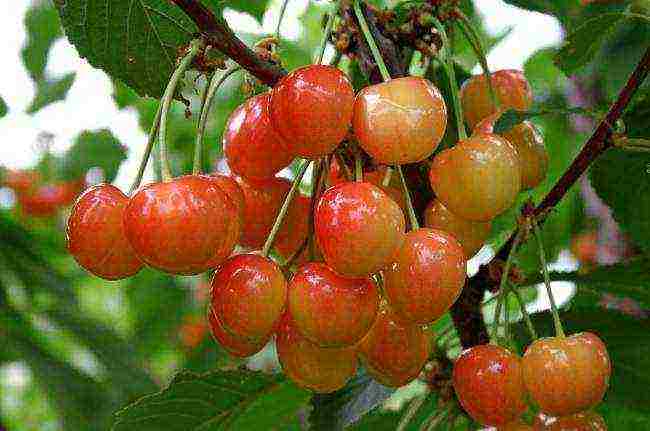
The variety was bred in 1999 by domestic breeders by free pollination of the Narodnaya sweet cherry. Recommended for growing in mid-latitudes.
The tree has an average vigor, its height reaches 3.5 m. The crown is pyramidal, slightly raised. Flowering begins in the second decade of May, the fruits ripen by mid-July. Fruiting occurs on fruit twigs and last year's shoots.
The berries are round, weighing up to 4 g. The skin is dense, pink in color. Inside there is a pinkish pulp with medium density. The stone is large, up to 4.5% of the weight of the fruit, it separates well. Dessert variety, received average tasting ratings.
The variety is self-fertile, has a high winter hardiness. Resistance to fungal diseases of stone fruit crops is relatively low. Productivity from a tree - up to 42 kg.
Narodnaya Syubarova

The variety was bred in Belarus by the famous breeder E.P. Syubarova. It is considered one of the best for growing in mid-latitudes and central regions of Russia.
The tree is strong and tall, due to which the resistance to wind and snow load increases, the branches are well developed. Saplings take root in any soil, even in marginal loam and sandy loam soil. The variety is completely self-fertile, does not need other pollinators. Begins fruiting in 3 years, the berries are formed by the second decade of July.
Fruits of medium size, weighing up to 6 g. The skin has a deep red color, pronounced shine. The pulp is red, juicy and tender. Received high tasting marks. The stone is small, well separated from the pulp.
The variety is winter-hardy, withstands severe frosts. Resistant to most typical diseases, cracking of fruits is not observed in hot seasons. Productivity - up to 50 kg / tree.
Ovstuzhenka
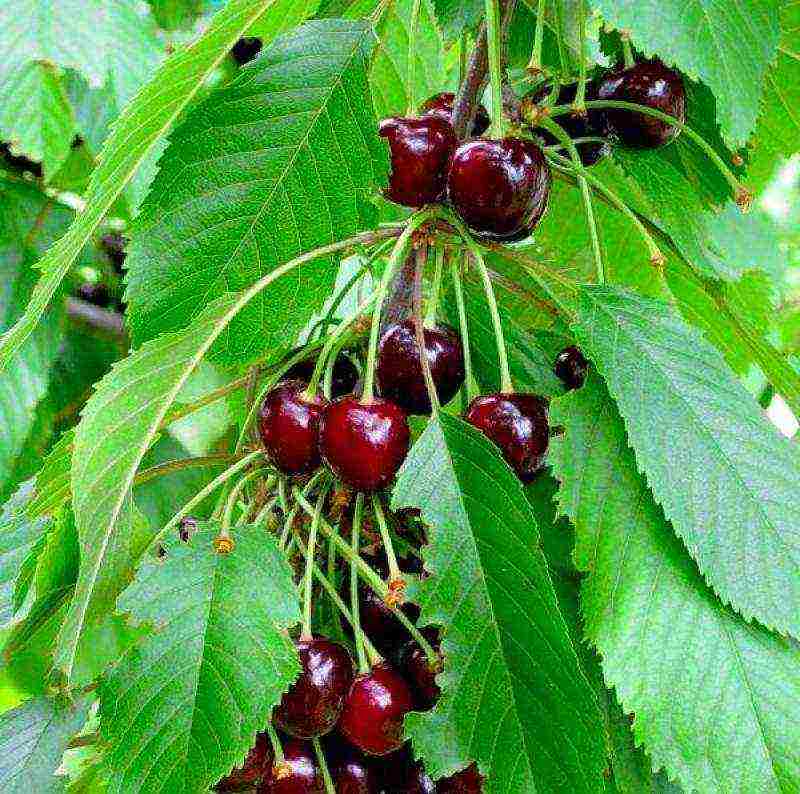
The variety was bred in 2001 at the Research Institute of Lupine using the hybridization of cherries of the Leningradskaya Black and Compact Venyaminova varieties. Suitable for cultivation in the southern and central regions, high yield rates have been identified in the black earth regions.
The tree is small in size but grows quickly. The crown is raised, spherical in shape. The leaf blade is ovate with double-serrate serration. Ovaries are formed only on bouquet twigs.
Large fruits can reach a weight of up to 6 g, the shape is oval or round. The skin is dense and shiny, has a dark red tint. The bone is small and can be easily separated. The pulp is deep red in color, has a sweet taste and a high tasting rating. Withstands transportation well, the variety has a universal purpose. The maximum yield is 30 kg / tree.
High rates of winter hardiness are observed, immunity to fungal diseases of stone fruit crops is developed. Low self-pollination, it is necessary to have other varieties nearby.
Gronkovaya
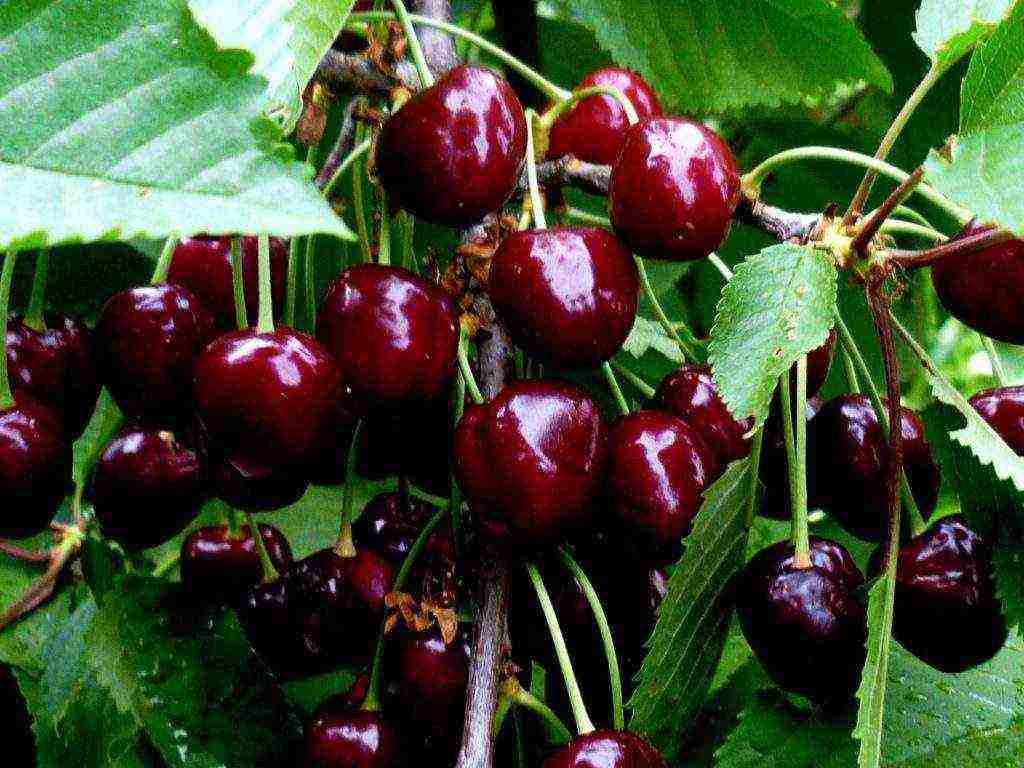
The variety was obtained by free pollination by Belarusian breeders in 1999. Widely distributed in the North Caucasus region and the Astrakhan region.
Sweet cherry is represented by a medium-sized tree with a wide-pyramidal crown. During planting, it is recommended to increase the space between the trees to avoid darkening. Fruiting begins in 3-4 years, harvesting is possible from the end of June.
The berries are even heart-shaped, the average weight of the fruits is 4-5 g. The skin is dark red in color with a pronounced waxy bloom. The pulp is rich red, medium density. The peduncle and stone are easily separated. The taste of the fruit is sweet and has average tasting ratings. Sweet cherries for universal use.
The variety is characterized by increased resistance to frost and disease. The tree is self-fertile, planting of pollinators is required. The yield is high - up to 20 kg / tree.
Backyard yellow
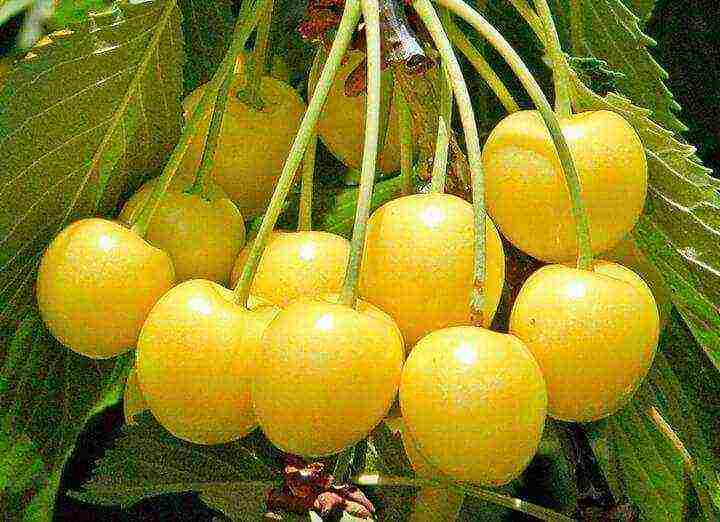
Variety of early ripening, bred at the Research Institute of Genetics and Breeding. IV Michurina in 1998 by crossing the Leningradskaya red and Zolotaya Loshinskaya cherries. Recommended for cultivation in the Central Region.
A fast-growing tree with a spherical crown of medium density. The leaf is large, has an oval-conical shape and a concave plate. Begins fruiting from the 6th year of life.
The fruits have an oval shape and a wide funnel, the average weight is 5.5 g. The skin is yellow without integumentary points. The pulp is juicy, gives an almost colorless juice. The berries have received high tasting marks and are used for table purposes.
The variety is self-fertile, has high frost resistance. The fruits do not crack in humid climates, have an attractive appearance and good transportability.
Red hill
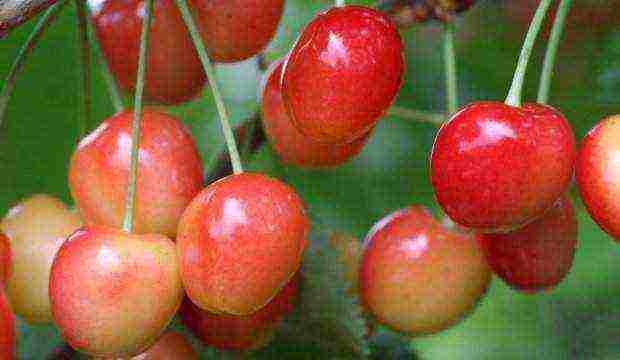
Bred at the Research Institute of Lupine under the guidance of the famous breeder M.V. Kanshina. Successfully passed field trials for cultivation in the Central Region.
The tree is weak, reaching a height of up to 3 meters, the most active growth is observed in the first year of life. The crown is thick, ovoid. Leaves are oval in shape, have a pointed end. Fruit formation occurs on fruit and growth shoots. Flowering begins in early May, fruiting - in the second decade of June.
The berries have a traditional heart-shaped shape, the average weight is 5-6 g. The color of the skin is golden with a pronounced red blush. The pulp is devoid of pigment, the stone is well separated during processing. Application - table, fruits received high tasting marks.
The variety is self-fertile. Possesses high immunity and winter hardiness. The yield is high - up to 45 kg / tree. The main disadvantage is poor transportability and short storage time.
Rechitsa
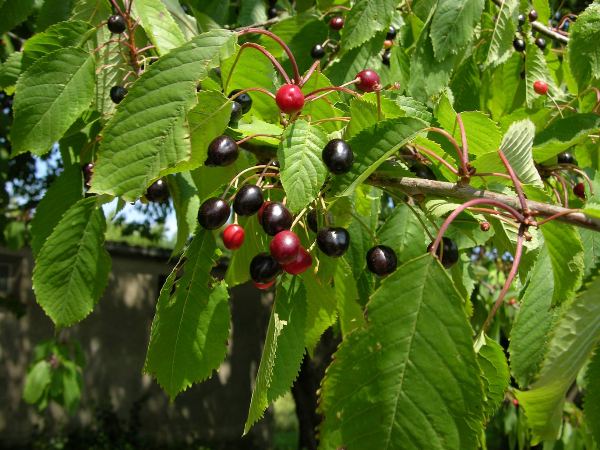
The variety was obtained on the basis of marker characteristics when growing sweet cherry Bryanskaya rozovaya. The development was carried out at the Research Institute of Lupine. Included in the official register in 2001.
The tree is fast growing. The crown is pyramidal, medium density. The leaf plate is green in color, has the shape of an ellipse. Fruiting is observed only on bouquet branches; it begins to bear fruit from the 5th year of life. Average ripening and flowering period.
The berries are round in shape, can reach a weight of up to 4.9 g. The color of the skin is almost dark red, almost black. The pulp is dense, inside which there is an oval bone. The berries are juicy and sweet to taste, universal use. Productivity up to 23 kg / tree.
Winter hardiness is high, there is resistance to characteristic fungal and infectious diseases of stone fruits. The variety is self-fertile, pollinators are required.
Leningradskaya
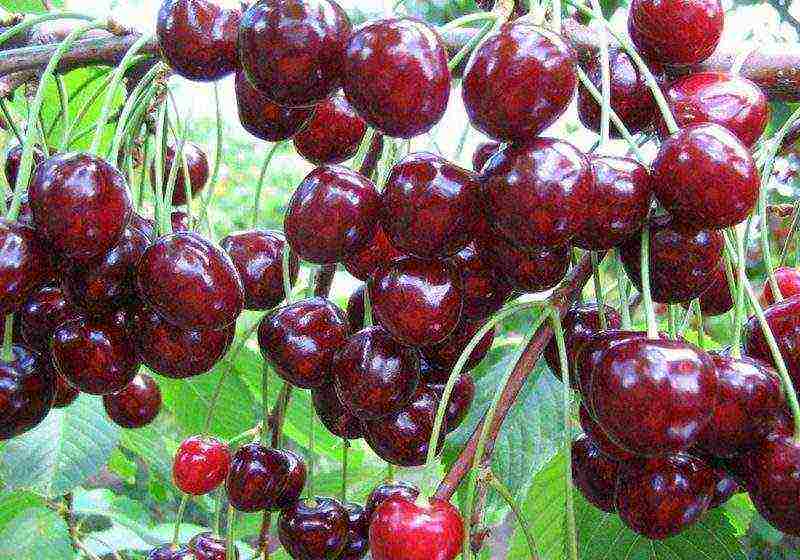
An early ripening variety bred at the Pavlovsk experimental station of the VIR. It is one of the first varieties of sweet cherry with high winter hardiness.
The trees are medium-sized, up to 4 meters high. Crohn's medium, wide pyramidal shape. Active fruiting begins at 3-4 years of age. In the conditions of the middle latitudes of Russia, ripening is observed from the second decade of July.
The berries are round in shape, weighing up to 3.5 g. The skin has an almost black color and a pronounced gloss. The pulp is fibrous, tender and juicy in taste. Tasting ratings are average, often used for preparing drinks.
The variety is extremely frost-resistant. Fruit shedding is extremely rare; in combination with a high yield (up to 40 kg / tree), it is one of the best varieties for the Central regions of Russia.
Large-fruited
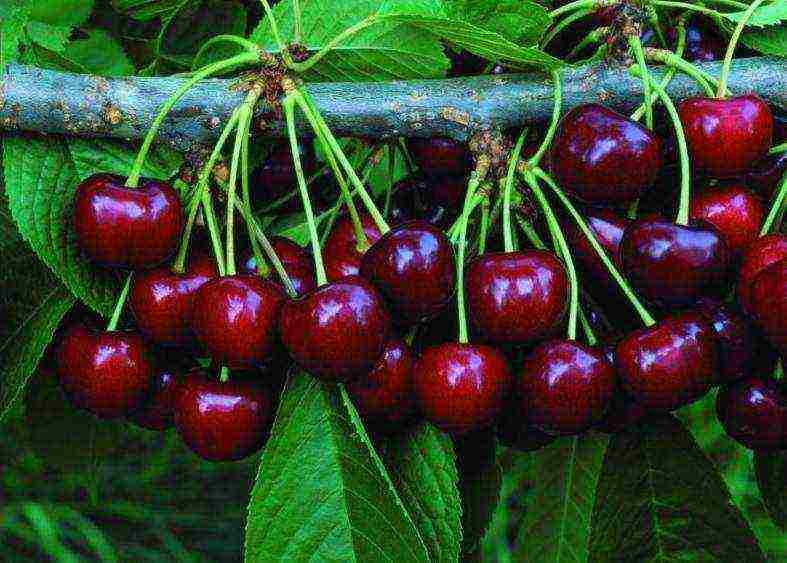
Bred in the 80s of the last century by Ukrainian breeders by pollination of a number of sweet cherry varieties. The fruits have received awards at various exhibitions several times.
The tree shows rapid growth at a height of 4-5 m. The crown is spherical with an average volume of foliage. The leaf plate is strongly elongated, has a pointed top. Fruits are formed on bouquet branches and last year's shoots. Begins fruiting from 4 years old. Late ripening period.
The berries are very large, they can weigh up to 13 g. They have a rounded shape and a dark red skin color. The pulp is dense, has medium cartilage. Taste - sweet and sour, average tasting ratings are obtained. The stone is large, but easily separated from the fetus. The type of application is universal.
This variety is often used for fresh sale as it has a long shelf life. Cracking of the crop is possible during wet seasons. Sweet cherry has a weak resistance to bacterial diseases, the indicators of frost resistance are high.
Michurinka
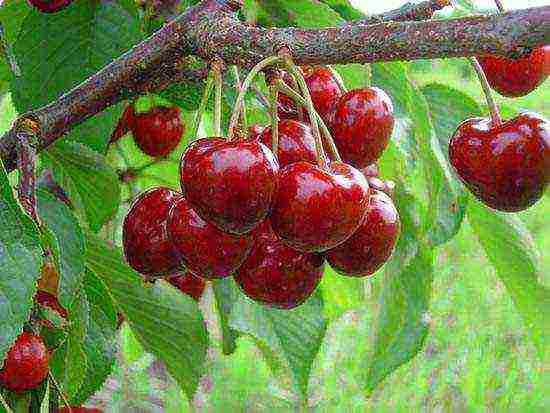
A hybrid variety obtained by employees of the N.I. Michurina by crossing Leningradskaya yellow cherries.
The tree is of medium height. The crown is oval, less often rounded. The leaf is in the form of an ellipse, there are no stipules, a very pointed tip is often formed. Begins fruiting after 5 years, late ripening of berries.
The fruits have an average weight of up to 4.7 g, heart-shaped. The color of the skin and pulp is dark red, the stalk is medium in size. The pulp is quite dense, inside which there is a large bone. The berries are sweet in taste and retain their presentation for a long time.
There is a relatively high resistance to fungal diseases and frost. The type of application is universal, often used for fresh consumption.
Italian

A variety of early ripening, bred by specialists from the N.I. Michurin by crossing the Bigarro and Slava Zhukov cherries. Field tested in 1995.
The tree is of medium vigor. The crown is pyramidal, the flowers are large and white. It begins to bear fruit in 4-5 years after planting.
The berries are large, the average weight is 6 g. The fruits are dark red, the skin has a waxy coating. The pulp has a pleasant taste and dense texture. Quite high tasting marks were obtained. The sweet cherry is easily separated from the stalk, does not crumble during the harvest period.
The variety is known for its high yield, it has resistance to a number of fungal diseases. Average frost resistance, used for fresh consumption and for the preparation of juices and preparations.
Lena
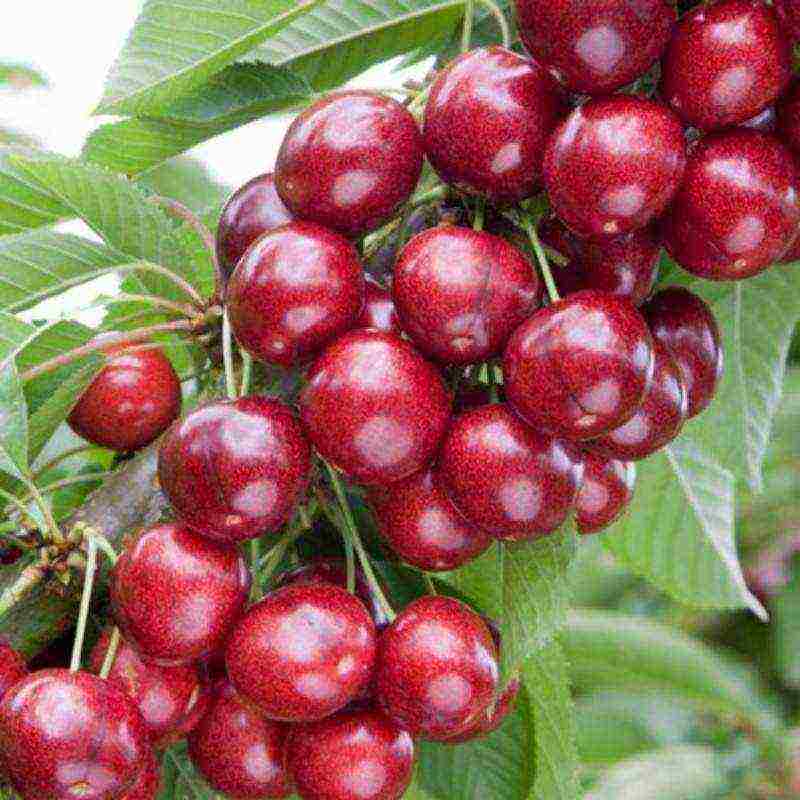
Hybrid variety of late ripening, obtained from sweet cherry Bryanskaya rozovaya. The development was carried out at the Research Institute of Lupine. All tests were passed in 2006.
The tree shows average growth rates, height up to 4 m. The root is oval, has an average density. The variety is self-fertile, fruiting occurs 4 years after planting on bouquet branches.
The berries are heart-shaped, the average weight is 6 g. The color of the skin is black-red, with a slight waxy bloom. The pulp has a sweet and sour taste, high tasting ratings. Recommended for fresh consumption, however, the type of application is universal.
Productivity is maintained only for 7 years, then it is necessary to vaccinate or transplant. There is resistance to fungal diseases and frost.
Sadko

An early ripening variety obtained at the Research Institute of Lupine by crossing several hybrid varieties of sweet cherries. Tested in 2005 in the Central region of Russia.
The tree has medium growth characteristics. The stem is prone to peeling, the crown is rounded. Fruiting is observed starting from 4 years after planting. Berries are formed on fruit branches and bouquet branches.
The fruits weigh up to 6.1 g, the shape is oval. The skin is colored dark red, possibly with small specks. The pulp is red in color, has a dense consistency and a pleasant taste. Resistance to fruit cracking is noted.
The Sadko variety has a high winter hardiness, but the pistils are susceptible to frost. Relatively high characteristics of immunity to fungal infections. Self-fertile type of pollination, good yield indicators.
Today there are dozens of names of sweet cherry varieties for cultivation in the middle regions of Russia. When choosing a plant for your garden, you should consider not only resistance to frost and disease, but also taste characteristics, as well as yield indicators. The taste and quantity of fruits depends a lot on the right care and climate in your area.
Review of the best varieties of cherries - according to gardeners' reviews
Sweet cherry is a sweet and aromatic southerner with early ripening. There is a high temptation to plant a slender tree on your site and feast on fruits with delicate pulp. According to the experience of gardeners in the Moscow Region, the Middle Belt and the Southern Urals, growing sweet cherries and obtaining a rich harvest is akin to art. The main problems that arise when planting a thermophilic tree in a harsh climate are associated with insufficient winter hardiness and susceptibility to diseases. It is these characteristics that you need to pay attention to when choosing the best cherry variety for the Moscow region.
Sweet cherries are self-fertile, therefore a pollinator variety with the same flowering period is needed to set fruits. Planting one tree is not enough. But as an alternative, you can graft a different variety into the crown of an adult tree. Sweet cherries are vigorous trees, and for normal development they are planted at a distance of 4 - 5 m. They form a powerful, deeply penetrating root system and do not tolerate close passage of groundwater. These features must be taken into account when assessing your site so that the planted trees do not have to be uprooted after a few years.
Read more about the best varieties of cherries for the Moscow region and the Middle Strip, the Urals, the southern regions in our rating, compiled according to reviews of experts and experienced gardeners.
The best varieties of cherries - Top 8
The best early varieties of cherries
|
Iput 500 (one-year-old in a container (ZKS)) Our rating of the best varieties of sweet cherries is opened by an early variety that ripens in mid-June. The tree is 4 - 6 m high. The crown is broad-pyramidal, dense. Fruits are leveled, weigh from 5 to 10 g, blunt-hearted, black-red, with dark red tender pulp of medium density, medium separation of the stone. The taste is juicy and sweet with sourness. Ripe fruits have an appetizing, attractive, presentation. With a lack of heat and sun, the fruits acquire a tart taste and pronounced sourness. In favorable years, 25 - 35 kg are harvested from one tree. Winter hardiness of this cherry variety is good, but in severe winters there is a slight freezing of the growth and average damage to flower buds. After returnable spring frosts, no more than 60% of the ovaries are damaged. Disease resistant.Recommended in the Central and Central Black Earth regions. In the Moscow region, Nizhny Novgorod, Penza and Samara, gardeners note good adaptive qualities. Pollinating varieties: Revna, Tyutchevka, Bryanskaya rozovaya, Ovstuzhenka and Raditsa. Main pluses:
Minuses:
|
 9.8 / 10 Rating Reviews A good, very early cherry variety, does not get sick. It ripens with me with garden strawberries. The fruits are large, but watery and sour.
|
|
Chermashnaya 850 (two-year-old in a container (ZKS)) Yellow cherry with early ripening. The tree is 4.5 - 5 m high. The crown is spherical, raised, not thickened. Fruits are one-dimensional, even, rounded, weigh on average 4 - 4.5 g, pale yellow, with a thin and dense skin. Dessert taste, sweet with a slight sourness. The pulp is juicy and tender, yellow in color, the separation of the stone is good. Uncomfortable ripening is observed. The average yield of an adult tree is 15 - 20 kg. The variety is absolutely self-fertile, that is, it will not tie a single fruit without a pollinator. For pollination, plant Fatezh, Raditsa or Bryansk pink. Differs in early maturity: fruiting begins 3-4 years after planting. Winter hardiness of wood is at the level of average, flower buds can be damaged by spring frosts. Recommended for growing in the Black Earth region. There is a positive experience of growing in the Moscow region, however, gardeners, after harsh winters, note the appearance of frost holes on the bark. Main pluses:
Minuses:
|
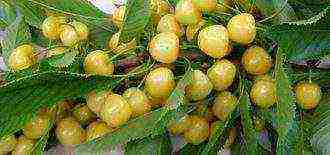 9.7 / 10 Rating Reviews Nice yellow cherry, the tree is just strewn with berries. I like the fact that when the neighboring red-fruited cherry ripens, our Chermashnaya does not attract starlings.
|
|
Ovstuzhenka 420 (one-year-old with open root system) A good variety of cherries with early fruit ripening. Trees 3 - 4 m high, with a dense, raised, spherical crown. The short stature of the trees makes harvesting easier and protects the fruit from starlings. Fruits are round, deep burgundy, weigh 4 - 7 g, the flesh is dark red. They are easily separated from the stalks, with a dry separation, the separation of the bone from the pulp is good, they do not crack. The taste is juicy and sweet, without astringency. The yield of one tree with good care and without damage is 50 - 60 kg, in the first years of fruiting - 10 - 15 kg. Partially self-fertile, therefore, even without a pollinator, it sets a small (about 5%) number of fruits. Pollinating varieties: Revna, Bryansk pink, Iput, Tyutchevka, Raditsa. Differs in high winter hardiness and frost resistance, including flower buds and ovaries. Shows high resistance to coccomycosis and moniliosis, moderately affected by clasterosporiosis. The variety is zoned in the Central region. There is a good experience of growing in Chelyabinsk and in the Central lane. Main pluses:
Minuses:
|
 9.7 / 10 Rating Reviews In general, we are satisfied with the variety. Good classic cherry in appearance and fruit taste. It does not cause problems and is always strewn with berries.
|
The best mid-season cherry varieties
|
Fatezh 850 (two-year-old in a container (ZKS)) The fruits ripen on average, from the second decade of July. The tree grows up to 4 - 5 m. The crown is sprawling, spherical, of medium density, needs to be shaped to maintain a compact shape. The lower branches droop under the weight of the harvest. Fruits are leveled, regular-rounded, weighing 3.8 - 6 g, yellow with a large red blush, with a dry separation from the stalk. The taste is juicy and sweet with a pleasant sourness. The pulp is pink, firm.The bone is easily separated from the pulp. Up to 50 kg are harvested from one adult tree, in the first years of fruiting, productivity is at the level of 10 - 30 kg. This cherry variety is recommended for cultivation in the Central region, Moscow region. Positive cultivation experience has been obtained in many areas of the Central strip. Chermashnaya, Revna, Ovstuzhenka, Raditsa or Iput are planted as pollinators. Main pluses:
Minuses:
|
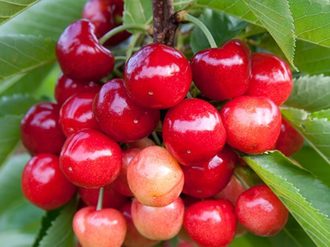 9.8 / 10 Rating Reviews The fruits are small, but the cherry harvest pleases, and even unripe fruits are quite sweet.
|
|
Gift to Stepanov 420 (one-year-old with open root system) A new medium-late sweet cherry variety of the Bryansk selection. The tree is 4 - 5 m high, with a pyramidal, sparse crown. Fruits are rich red or burgundy, weighing 3.5 - 4.5 g, aligned, blunt-hearted, with dark red, juicy, cartilaginous pulp and delicate skin. Dessert taste, estimated at 4.9 - 5 points. The peduncle comes off easily, the stone is separated well. In the description of this cherry variety, good resistance to major diseases and high winter hardiness are declared. In the State Register since 2015, zoned for the Central Region. Also, gardeners grow this cherry variety in Nizhny Novgorod and Chelyabinsk. Main pluses:
Minuses:
|
 9.7 / 10 Rating Reviews One-year cherry seedling quickly took root and started to grow, it adapts well to growing conditions.
|
The best late varieties of cherries
|
Bryansk pink 850 (two-year-old in a container (ZKS)) A versatile late ripening cherry variety. The tree is 4 - 4.5 m high and has a slow growth rate. The crown is wide-pyramidal, raised, moderately thickened. Fruits are pink with a tan and a characteristic speck, weigh on average 4 - 5.5 g, regular rounded shape, with a dry separation, do not crack when waterlogged. The pulp is dense, yellow, with weak cartilage. Light juice. The separation of the bone from the pulp is average. The taste is juicy and sweet, with a slightly pronounced bitterness. One tree bears an average of 20 - 30 kg of fruit. Ovstuzhenka, Tyutchevka, Iput and Revna are suitable pollinators. Resistance of the trunk and skeletal branches to frost breakers is observed. High winter hardiness of wood and flower buds, sensitivity to spring frosts. High resistance to coccomycosis, moniliosis and clasterosporiosis. Recommended for cultivation in the Central region, widespread throughout the Middle Belt. Main pluses:
Minuses:
|
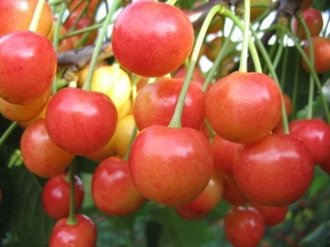 9.8 / 10 Rating Reviews Good cherry for the Moscow region, the fruits are smallish, but sugary-sweet. The variety is not sore and not capricious, but the yield is stable.
|
|
Jealous 730 (two-year agronomic grid) A good proven variety of late-ripening cherries. The tree is fast-growing, 4 - 5 m high, with a sparse pyramidal crown. It lends itself well to all types of shaping. Fruits are beautiful, broadly rounded, weigh from 5 to 8 g, dark red, almost blackening when ripe, with dry separation, transportable. The pulp is rich red, dense. The bone is separated well. The taste is juicy and sweet, gaining 4.8 - 5 points during tasting. The average productivity of one tree is 30 kg. The variety is partially self-fertile: without a pollinator, sets up to 5% of the potential number of fruits. Good pollinators are Ovstuzhenka, Tyutchevka, Raditsa, Iput. The stem and skeletal branches are not affected by frostbites. Shows high winter hardiness and good resistance to recurrent frost. Differs in good immunity.Zoned in the Central Region, but actively grown throughout the Middle Lane. Main pluses:
Minuses:
|
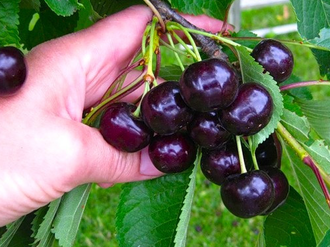 9.8 / 10 Rating Reviews A young tree is always healthy and strong, even after a harsh winter it looks better than other sweet cherries.
|
|
Tyutchevka 420 (one-year-old with open root system) Late sweet cherry, ripens at the end of July. The tree is medium-sized, 4 - 6 m high. The crown is spherical, sparse, moderately spreading. Fruits weigh from 5 to 7.4 g, rounded with a wide base, red with specks. The pulp is firm, red. The separation of the bone from the pulp is average. Fruits are transportable, with dry separation. The taste is excellent. Up to 40 kg can be harvested from one tree annually. The variety is partially self-fertile. Iput, Raditsa, Revna or Ovstuzhenka are planted for pollination. In the conditions of the Moscow region, gardeners note the cracking of berries when rainy weather is established during the ripening period. To a moderate extent, it is affected by clasterosporia and coccomycosis, very rarely by moniliosis. In severe winters, the trees freeze slightly. Spring frosts during the flowering period can destroy up to 70% of the ovaries. Zoned for the Central region, successfully grown in the Middle zone and the South Urals. Main pluses:
Minuses:
|
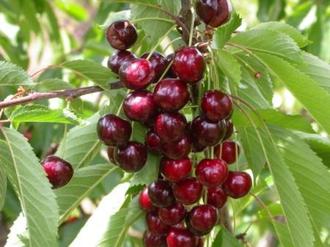 9.7 / 10 Rating Reviews The best cherry for the Moscow region, in my opinion. Surprises with high frost resistance. I rate the fruits at 5 points, even unripe sweet ones, and the children eat with pleasure.
|
Members of the forum also recommend cherry varieties in reviews: Rossoshanskaya rose, Bryanochka, Teremoshka, Milan, Pamyat Astakhov, Raditsa and Valery Chkalov. When choosing cherries for their site, gardeners of the Middle Lane often prefer medium-sized and winter-hardy varieties.
For cherries, as for a thermophilic culture, spring planting is desirable. They buy seedlings with unblown buds. If the leaves have opened in the warmth, then the seedling must be urgently planted in the ground in order to prevent the drying of the shoots and roots. In regions with a protracted spring, it is better to buy planting material with a closed root system: in a container, the tree will painlessly endure the wait for planting. The planting hole is prepared in the fall, and the soil mixture for backfill is stored in a closed unheated room. These measures will allow you to land at the earliest possible date.
With cherries, there are very frequent cases of re-grading, when southern varieties are passed off as zoned ones. Cherry seedlings are best bought from trusted stores, local nurseries or reputable private gardeners.
We wish you a good harvest!
Attention! The reliability of the information and the results of the ratings is subjective and does not constitute advertising.
There is hardly a person who would not like cherries. Modern breeders are developing all new varieties with improved characteristics - more frost-resistant, with genetically "built-in" immunity, and so on. Cherries in the countries of the former USSR can now be grown not only in areas with a warm subtropical climate, but also in regions with relatively short summers and cold winters. The most difficult thing is to make a choice from the available variety. All other things being equal, preference is often given to self-fertile varieties. This allows you to save space in the garden, which is very important for the owners of the notorious "six acres".
For the Northwest region
The climate in the Northwest region of Russia is unpredictable. Summer there, as a rule, is not too hot and sunny, and winter can turn out to be moderately cold and abnormally frosty, moreover, with little snow. For cherries, such conditions are not optimal, therefore the main selection criterion is frost resistance.
Self-fertile varieties of cherries differ from ordinary ones in that they are able to tie a crop without the presence of pollinating trees nearby. Consequently, there is no need to plant several cherries at the same time on the garden plot, because the hope for those that grow with neighbors is far from always justified. This allows you to significantly save space, which is always in short supply. Most of the self-fertile varieties have appeared relatively recently, therefore, they are characterized by the presence of other advantages, for example, frost resistance, immunity to diseases typical of the culture, high yields, early maturity, and so on.
Backyard yellow
A relatively recent achievement of Russian breeders. The "parents" of the variety are Leningradskaya Krasnaya and Zolotaya Loshitskaya. Household yellow belongs to the category of early varieties. It is recommended by the State Register of the Russian Federation for cultivation in the Black Sea region, but practice shows that this cherry can withstand and successfully adapt to much more severe climatic and weather conditions.
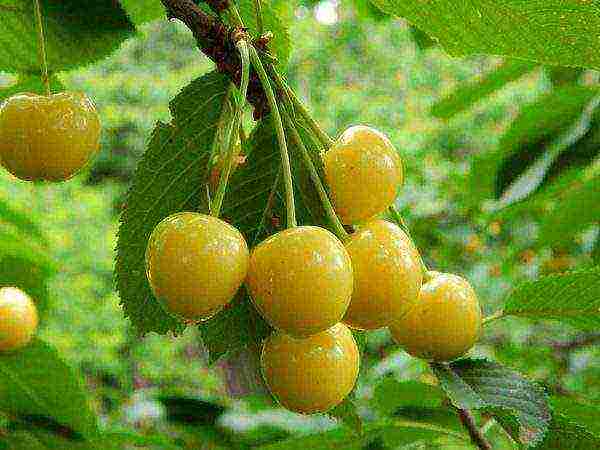
Sweet cherry Priusadebnaya yellow is a modern Russian variety, practically devoid of shortcomings
The sapling is distinguished by its growth rate, the adult tree is quite large, with a wide, almost spherical crown. At the same time, it is not very thickened, therefore, caring for the plant and harvesting is not particularly difficult. The tree blooms very beautifully, the flowers are large, snow-white, collected in inflorescences of three.
The berries are medium in size, round, weighing 5–6 g and about 2–2.2 cm in diameter. The lateral seam is not very pronounced. The skin, as you might guess from the name, is bright yellow, smooth. The subcutaneous points are completely absent. The pulp is lighter than the skin, the juice is almost colorless. The taste is sweet and sour, but very balanced. It is rated quite high by professional tasters - 4.7 points out of five. The stone is small, easily separated from the pulp.
The frost resistance of the tree is at the level of -30 ° C. Flower buds rarely suffer from recurrent spring frosts. The first fruiting is expected 5–6 years after the cherry is planted in the ground. Further, the harvests are annual. Even fully ripe berries do not crumble, they rarely crack in damp weather. The backyard yellow is bypassed by such a dangerous pest as a cherry fly.
Video: home garden yellow cherry
Bereket
The sweet cherry variety was bred in Dagestan by crossing the varieties of Drogan yellow and April black. The creators position the variety as self-fertile, but practice shows that it is more likely to speak from partial self-fertility. The state register of the Russian Federation advises to grow Bereket in the North Caucasus, but with frost resistance up to -30–32 ° C, the variety is quite suitable for the North-West region, other regions with temperate climates. The cold hardiness of flower buds is very high - 95–98%.
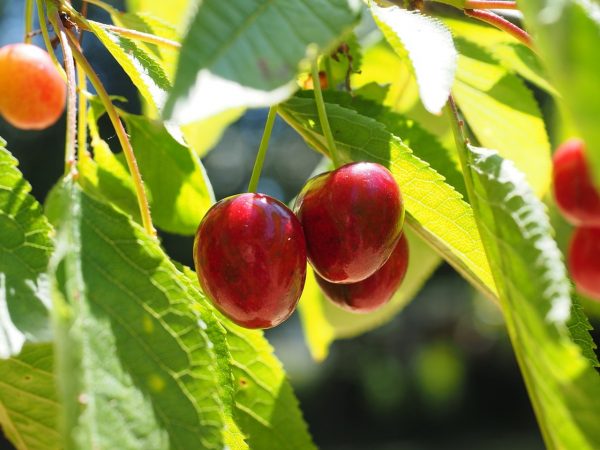
The flower buds of Bereket cherries are very frost-resistant.
Cherry Bereket medium early. When flowering in the last decade of April, it ripens in early or mid-July. The first harvest is tried 4–5 years after the tree has been planted.
An adult tree grows up to 5 m or a little more, differs in a spreading, rather "sloppy" thickened crown. Annual shoots are colored lilac green. The leaves are calyx-like, sagging slightly along the central vein.
The berries are medium in size, weighing 5.5–6.5 g and a little over 2 cm in diameter. The skin is dark scarlet, the flesh is pink-red. In it, veins are clearly distinguished, much lighter. Light acidity does not spoil the taste, which is rated by professional tasters at five points out of five possible. The stone is very small, weighing about 0.5 g. The berries are easily separated from the stalk, so mechanized harvesting is possible. In cool, damp weather, about one in five fruit will crack.
The average yield of Bereket cherries is 20–25 kg per adult tree. Berries are notable for good transportability. Fresh they can be stored for about a week. A significant drawback is the tendency to defeat moniliosis.
Goryanka
Another achievement of breeders working at the Dagestan Experimental Station. The "parents" of the Goryanka are French varieties of cherries Gaucher and Zhaboulet. When flowering at the end of the second decade of April, the harvest ripens in the first half of July.
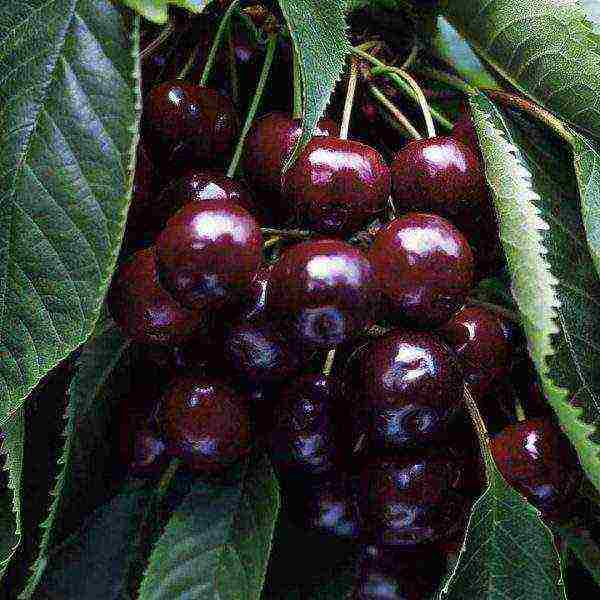
Cherry Goryanka belongs to varieties with a bouquet type of fruiting
The height of an adult tree is 3.5–4 m. The crown is densely leafy, in the form of a pyramid with a wide base. Nevertheless, practice shows that you can limit yourself to sanitary pruning. Annual shoots of lettuce color. The edges of the leaf are smooth, slight "serration" appears only closer to the tip. Flowers are small, collected in inflorescences in the shape of an umbrella, 5-7 pieces. The crop ripens exclusively on bouquet branches.
Heart-shaped berries with a rounded base. The side "seam" is practically absent. The average weight of one sweet cherry is 6–6.5 g. The skin is wine-burgundy, the pulp is intensely scarlet, the juice is of the same color. The taste is excellent, has earned a professional rating of 4.9 points out of five. The berries do not differ in transportability; fresh they can be stored for 5-6 days. The average yield is 18-22 kg per tree. The berries ripen at the same time. The first fruits will have to wait 4–5 years.
Frost resistance of Horny Goat Weed is at the level of -28–30 ° С, of flower buds - about 90%. Even open flowers rarely suffer from recurrent frosts. The variety tolerates short-term drought well, but with a prolonged moisture deficit, the tree practically stops growing, the shoots dry out and die off.
Dunn
One of the latest achievements of Russian breeders. The “parents” of the variety are the same as those of Priusadebnaya yellow, but the result of the crossing turned out to be completely different, although Danna also belongs to the category of early varieties. It got into the State Register in 1999 after zoning in the North Caucasus.
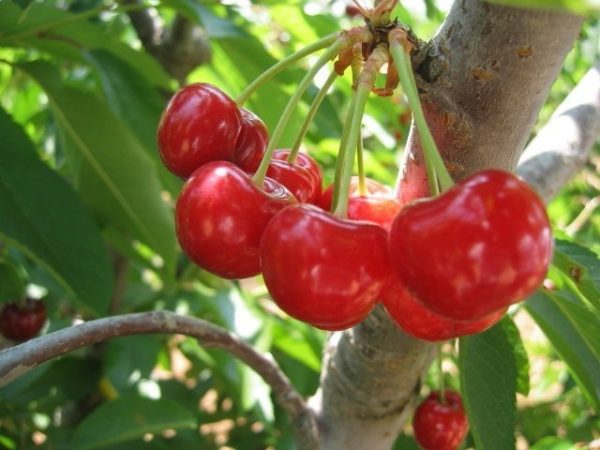
Danna is a promising Russian cherry variety; it is also interesting for those who grow berries on an industrial scale.
The tree is of medium height, about 4 m. The crown is in the form of a pyramid, quite rare. Shoots are reddish brown. The leaves are light lettuce, rather narrow and elongated for cherries. The buds are collected in inflorescences strictly in three.
The berries are medium-sized, weighing 4.5–5.5 g and 1.6–1.8 cm in diameter, but very sweet. The taste has earned a rating of 4.7 points out of five from the experts. The skin is deeply scarlet, monochromatic, smooth. The fruits are distinguished by a high content of vitamin C - more than 10 mg per 100 g. The lateral "seam" is poorly expressed.
Danna is characterized by resistance to adverse weather conditions - cold (up to -35 ° C), heat, drought. This sweet cherry rarely suffers from diseases typical of the culture, and is rarely affected by pests. For almost two decades of cultivation, no significant shortcomings have been found. Those who grow fruits and berries on an industrial scale are showing an increased interest in the variety. The first fruits will have to wait 5-6 years.
Pridonskaya
Another Russian sweet cherry variety, bred at the I.V. Michurin Research Institute as a result of crossing the Zolotaya Loshitskaya and Rannyaya Marka varieties. The fruits ripen at the beginning of the second decade of July. Pridonskaya is considered self-fertile, but practice shows that planting nearby varieties Revna, Iput has a positive effect on yield.
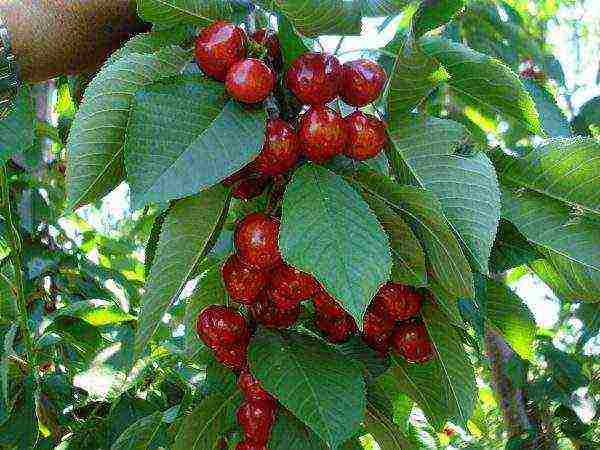
The cherry tree of the Pridonskaya variety is quite compact, it also does not differ in its growth rate
The tree is not tall (up to 3.5 m), the growth rate does not differ. Crohn is quite rare. Shoots are dark red, with an almost imperceptible brownish undertone, covered with well-distinguishable whitish lenticels. The buds are collected in inflorescences of three. More than 90% of the harvest ripens on bouquet branches.
The average weight of a berry is 5–6 g. They are one-dimensional, as if calibrated. They are easily separated from the stalks.The skin is blood-red, the flesh is pink-red (artists call this color scarlet), very juicy. Light "cartilages" are well discernible. The taste is sweet and sour, refreshing.
Pridonskaya has a high immunity against diseases typical for the culture, it is bypassed by most pests. The tree suffers little from heat and moisture deficit, in winter it tolerates frosts down to -25-28 ° C without much damage to itself. Flower buds are resistant to recurrent spring frosts.
The first harvest has to wait 6-7 years, then annual fruiting. Average yields are 20-25 kg per mature tree. The plant does not need formative pruning, it is quite enough sanitary. The variety is quite suitable for growing on an industrial scale. There are no significant shortcomings in the Pridonskaya cherry. Since 1999, when the culture was included in the State Register of the Russian Federation, it was not possible to identify them.
Valery Chkalov
One of the old well-deserved varieties, which has not lost its popularity to this day. This is a "natural" hybrid obtained as a result of spontaneous pollination of the Caucasian pink cherry. State trials began in the mid-50s of the last century, in 1974 the variety was recommended for cultivation in the North Caucasus, from where it gradually spread to territories with a temperate climate.
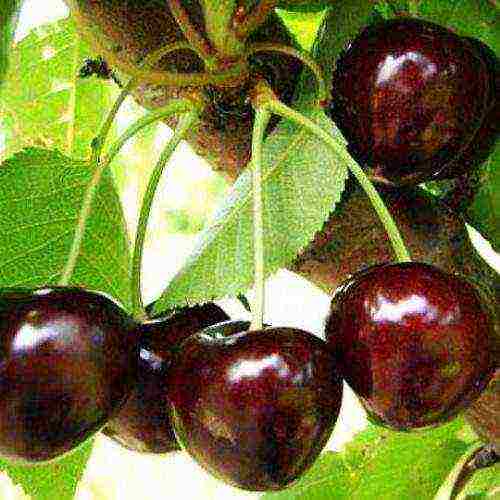
Cherry Valery Chkalov is one of the varieties that have successfully passed the test of time
The tree grows to 5.5–6 m in height and has a fairly dense pyramid-shaped crown. With age, it seems to "squat", the crown becomes more spreading. Shoots are grayish brown, powerful. They very often bend under their own weight or under the weight of the crop. The bark is rough to the touch. Leaves are ovoid, sharply tapering towards the tip. Flowering occurs in early April, fruiting in the first decade of July.
The berries are large, weighing 6–8 g, in the form of an almost regular ball or heart with smoothed outlines. The skin is painted in a very dark red color, from a distance the cherry appears black. The juice is rich scarlet. The stone is rather large, it is not too readily separated from the pulp. The taste is sour, but very pleasant. The content of vitamin C is almost a record - 21.5 mg per 100 g.
Fruiting begins five years after planting in the ground. The crop ripens annually. From an adult tree, depending on the growing region, you can remove from 60 to 150 kg of berries. Frost resistance up to -25ºС. A significant drawback is the tendency to attack by pathogenic fungi, especially those that cause gray rot and coccomycosis. Nevertheless, the tree is very hardy, capable of recovering even from serious damage.
The variety is considered partially self-fertile, the presence of cherries nearby Early Mark, Bigarro Burlat, Zhabule, Aprilka, Skorospelka contributes to an increase in yield. Valery Chkalov is one of the most popular types of cherries for breeders' experiments. With his participation, the varieties Valeria, Annushka, Farewell, Donetsk beauty and many others were bred.
Cherry variety Valery Chkalov
For Belarus
The climate of Belarus is in many ways similar to that characteristic of central Russia. Accordingly, varieties suitable for the North-West region can be successfully grown on the territory of this republic. Other, less frost-resistant Russian varieties of cherries are willingly planted there. The Belarusian breeders also have their own achievements, which are popular with fellow citizens.
Gorgeous
Sometimes found under the name Etok beauty. The variety has a consistently high yield. Bred in the Stavropol Territory by crossing the Denissen yellow and Dyber Black varieties. An essential advantage is absolute resistance to coccomycosis.

Cherry Beauty, indeed, looks very presentable
The variety is partially self-fertile. To increase the yield, the cherries of Diber, Golubushka, Franz Joseph, Narodnaya are planted nearby. Due to late flowering, the Beauty almost never falls under returnable spring frosts.
The tree reaches a height of 3.5–4 m, the growth rate does not differ. The crown is spreading, pyramidal or almost spherical. There are relatively few shoots, they are located in relation to the trunk at an angle of about 50º. The surface of the leaf is slightly wrinkled. Most of the harvest ripens on bouquet branches at the age of 2–5 years.
The average weight of a heart-shaped berry is 8-9 g. Fruits are slightly flattened. The seam is almost invisible. The skin is bright yellow with a golden sheen. The pulp is yellowish, very juicy and sweet. The juice is almost colorless. The stone is not large, it is separated from the pulp without effort. The harvest ripens in the first decade of July. The fruit is characterized by very good transportability.
The variety is fast-growing, the tree bears fruit for the first time 3-4 years after planting in the ground. About 40 kg of berries are removed from plants under the age of 10, by the age of 15 this figure doubles.
Ovstuzhenka
The variety was bred in 2001 by one of the most famous breeders in this area - M.V. Kanshina. In Russia, the State Register is recommended for cultivation in the Central Region. Ovstuzhenka is considered self-fertile, but the presence of pollinating varieties is still recommended - Revna, Tyutchevka, Pink Pearl, Bryanskaya Pink.
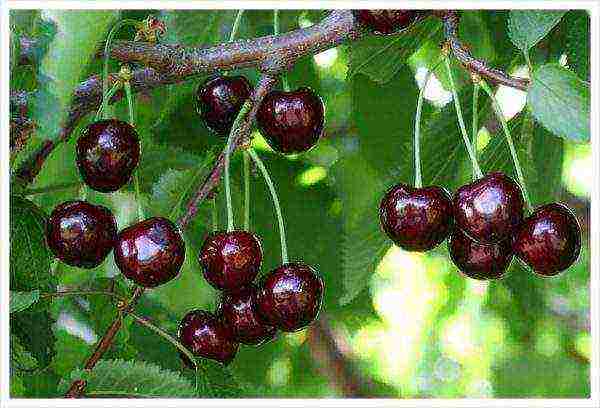
Winter hardiness of cherries of the Ovstuzhenka variety allows them to be grown in regions with any climate, with the exception of the subarctic
The tree is distinguished by its growth rate, therefore, it reaches its “ceiling” of 3–3.5 m by the fourth year of its life. After the first fruiting, it grows mainly in width. His crown is not too thickened, almost spherical. The flowers are large, collected in inflorescences of three. Snow-white petals overlap. Flowering occurs in early April.
Most of the fruits weigh 4–4.5 g, but there are also “champions” weighing 7–7.5 g. The berries are round or slightly elongated. The skin is very dark with a purple tint. From a distance, the berries appear almost black. The pulp is not too firm, but very juicy, bright red. The stone is small, easily separated from it. Sweet and sour taste is rated 4.5 out of five.
The berries ripen in late June or early July. The first fruiting will have to wait 4–5 years. Young trees bring 15–20 kg of berries, then the yield increases to 30–35 kg.
Ostuzhenka has a very high frost resistance of wood (up to -45 ° C), and somewhat less - of flower buds. Also, the first almost never gets sunburn in winter. Up to 15% of buds can suffer from return frosts in spring. She never suffers from moniliosis and coccomycosis, but can become infected with clotterosporia.
Narodnaya Syubarova
The main distinguishing feature of this Belarusian variety is a very powerful tree. It grows up to 5-6 m in height, the crown is extremely wide. Accordingly, she is not afraid of any, even the strongest, winds; branches rarely break under the weight of snow. Also, the variety is valued for its undemanding quality of the substrate.
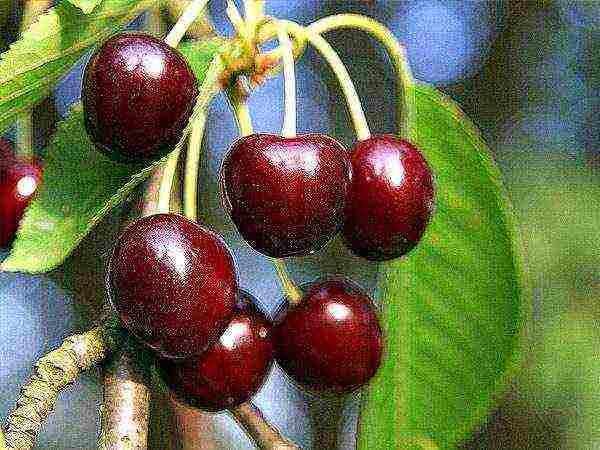
Cherry variety Narodnaya Syubarova is distinguished by its general unpretentiousness and undemanding to the quality of the substrate
The fruits are dark scarlet, the skin is glossy. The average weight of a berry is 5.5–6 g. The yield is at the level of 50–55 kg per mature tree. The first fruits are removed 4 years after the tree is planted in the garden. Cherry ripens en masse, in the middle of the second decade of July. Fruiting is annual.
The variety has an "innate" immunity to coccomycosis, rarely suffers from other fungal diseases. Self-pollination at the level of 90%.
Gastinets
Sometimes the spelling "Gastsinets" is found. One of the most popular Belarusian varieties. "Parents" - Red dense and Aelita. Belongs to the category of medium early (ripens in mid-July) and partially self-fertile. To increase yields, you can plant Narodnaya, Zhurba nearby.
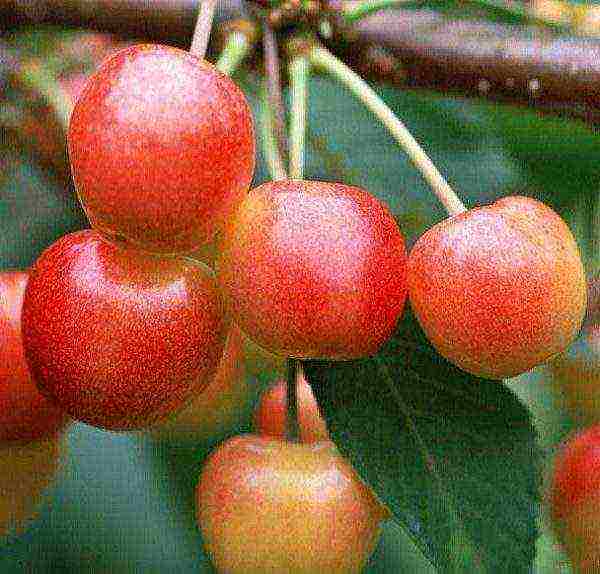
A significant advantage of Gastinets cherry is its resistance to coccomycosis
Winter hardiness at the level of -25 ° C. The tree bears fruit annually. The variety has an "innate" immunity to coccomycosis. Differs in early maturity. The first berries are tried three years after planting.
The fruits are large, heart-shaped, weighing about 7 g. The skin is bright yellow, the blush where the sun hits it is crimson or raspberry. The pulp and juice are almost the same color as the skin.
Tyutchevka
A popular Russian late cherry variety, bred at the beginning of the 21st century on the basis of the Red dense variety and a hybrid with the code name 3–36. In the Russian Federation, the State Register is recommended for cultivation in the Central Region, respectively, and for Belarus it is quite suitable. Due to partial self-fertility, it is recommended to plant pollinators (Revna, Iput, Raditsa).
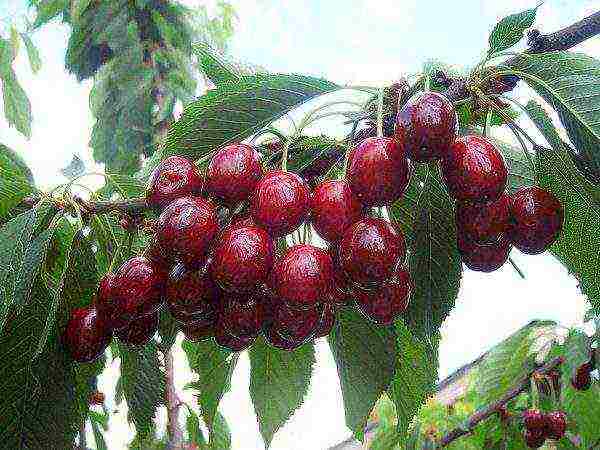
Cherry Tyutchevka is not devoid of significant flaws, but this does not affect its popularity in any way
The tree is relatively low, up to 4 m. It reaches its maximum size already 4–5 years after planting. The crown is in the form of a ball, sparse. Leaves with very short petioles. The buds are collected in inflorescences of four. Approximately 85% of the fruits ripen on bouquet branches.
Berries weighing 5–7.5 g, dark scarlet with lighter subcutaneous dots. The stone is small, reluctantly separates from the pulp. Fruits are sweet, but "cartilage" is clearly felt in the pulp. However, the taste is rated 4.9 out of five. The harvest ripens in the first decade of August. 18-25 kg of berries are removed from a mature tree. The first fruiting is five years after planting.
Among the disadvantages of the variety are berries that crack in rainy summers and the low winter hardiness of flower buds. More than 70% of future buds can suffer from recurrent frost. There is also a tendency to defeat coccomycosis and clasterosporium.
In memory of Astakhov
Another late cherry variety, ripening closer to mid-August. The tree is 4–4.5 m high, with a rounded, not too thickened crown. Differs in growth rate. The bark is grayish, highly flaky; after the leaves fall, it acquires a silvery hue.
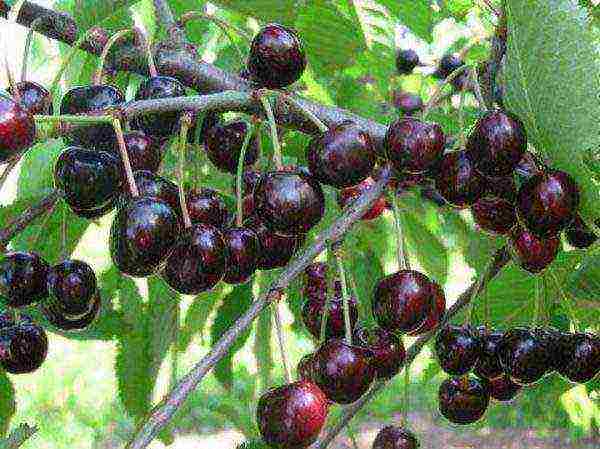
Cherry in Memory of Astakhov belongs to varieties of late ripening
The fruits are very presentable - one-dimensional, large (8 g or more). Deep burgundy berries. The stone is small, it separates well from the pulp. The skin is thin, smooth. The berry flavor is rated 4.8 out of five. Average yield is about 30 kg per tree.
The variety is rarely affected by diseases typical for the culture, its winter hardiness is at the level of -25-28 ° C. The berries ripen 5–6 years after the seedling is planted.
For Ukraine
The climate in most of the territory of Ukraine is much milder than in Russia and Belarus. Accordingly, local gardeners can afford to choose a cherry variety, focusing not only on winter hardiness, but also on the size, taste of the fruit, and yield. Recently, varieties from Europe and North America, which are grown in their homeland on an industrial scale, are gaining more and more popularity.
Annushka
A popular Ukrainian variety obtained with the participation of Donchanka cherries and Valery Chkalov. In Russia, he also received recognition, in 2000 he got into the State Register. It is recommended for cultivation only in the North Caucasus and the Black Sea region, but its high (-32–35 ° C) winter hardiness allows it to be grown in temperate climates.
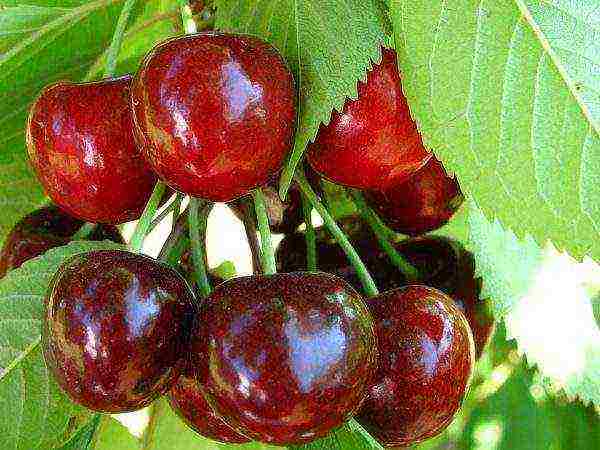
A flowering cherry tree of the Annushka variety looks very unusual
The tree is of medium height, 4–4.5 m. The crown is not particularly thickened. The shoots are thick. The buds are collected in inflorescences of 3-4 pieces. Flowers open before leaves appear.
Annushka is distinguished by presentability and large (9–10 g) berries. Deep scarlet skin. The pulp is slightly lighter, very sweet and juicy. Moreover, it is quite dense, which provides good transportability. Fruits are round, slightly flattened towards the base. Average yield is 20-22 kg.
The taste of the berries is little influenced by the way summer turns out. Annushka rarely suffers from drought, disease (with the exception of coccomycosis) and pests. The tree brings its first harvest in 3-4 years. For 10-12 years of fruiting, there is one "rest" season. This cherry variety requires careful site selection, being particularly sensitive to excessive soil moisture due to groundwater close to it. The tree grows quickly and therefore needs regular pruning.
Tenderness
An old well-deserved variety, bred in the 60s of the last century in Kiev on the basis of Drogan yellow and Francis cherries. Differs in winter hardiness up to -30 ° C, belongs to the category of mid-season. The harvest ripens in the last days of June. Because of this, it is not affected by the cherry fly - adults simply do not have time to lay eggs. The tree is up to 3 m high, the crown seems to be flattened, in the form of a wide oval.
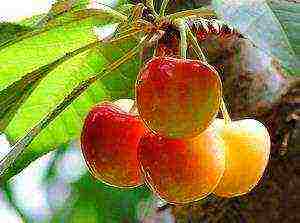
Cherry fruits of the Tenderness variety are very sensitive to any mechanical stress
The fruits are very presentable - golden yellow with a bright crimson blush, one-dimensional, weighing 6.5-7 g. But you need to remove them from the tree very carefully - even from the lightest pressing on the skin, ugly brown spots blur. The "seam" is clearly visible. The pulp is pale yellow, its taste is pleasant, sweet and sour. Tasting score - 4.7 points out of five.
The first time Tenderness bears fruit 6 years after planting. 50-60 kg of berries are removed from an adult plant. Moreover, the more fruits, the smaller they are. To increase the yield (although the variety is formally self-fertile), Drogana, Nectarnaya, Kitaevskaya black are planted next to Tenderness.
Video: what sweet cherry looks like Tenderness
Backyard
One of the earliest varieties of sweet cherries. The fruits ripen in the first decade of June. The berries are one-dimensional, the skin is pale yellow with a vague pinkish "blush". The pulp is light, creamy. The yield is extremely high (80 kg or more). Some amateur gardeners even consider this a disadvantage. Fresh fruits are stored for a very short time and do not differ in transportability. Accordingly, you need to eat or process berries in record time. Taste qualities are rated highly - by 4.8 points out of five possible.

Unfortunately, the shelf life of Home Garden cherries is very short.
The fruits do not crack, even if heavy rains fall during their ripening. The first time a sweet cherry ripens 3-5 years after planting a seedling. The tree is of medium height (3.5–4.5 m), the crown is rather sparse, but spreading. The average weight of the berry is 5-6 g.
Planting nearby cherries Valery Chkalov, Skorospelki, Bigarro Burlat helps to increase the yield of a partially self-fertile variety. Frost resistance is quite sufficient for growing in most of the territory of Ukraine. The tree is rarely affected by moniliosis, coccomycosis, "black cancer". Due to the early maturity, the cherry fly does not have time to lay eggs in the fruit ovaries.
Valeria
One of the most successful of the many varieties bred with the participation of cherries Valery Chkalov. His homeland is Ukraine, where he is grown everywhere. Valeria is distinguished by its large-fruited and excellent taste of berries. Another significant plus is resistance to infection by pathogenic fungi and pest attacks. The variety is partially self-fertile.

Valeria is one of the many varieties bred with the participation of cherries Valery Chkalov
The tree is vigorous, the crown is rather dense, almost spherical. Valeria blooms late, so it is guaranteed that it does not fall under return spring frosts, although in most of the territory of Ukraine this is a rather rare phenomenon.
The average weight of a heart-shaped berry is 9–10 g. The skin is dark-burgundy, the flesh is slightly lighter. The pulp is soft, not very dense, juicy. To increase productivity, it is desirable to have pollinators - Donchanka, Annushka, Lesya, Ugolyok. Ethics is categorically not suitable in this capacity. Fruiting is annual, an adult tree bears 30-50 kg of berries.
Lapins
Canadian cherry, bred on the basis of the popular varieties of Van and Stella in their homeland. Belongs to the category of late, the harvest ripens in the last decade of July or early August. Lapins is a completely self-fertile variety, practice shows that in the absence of pollinators, as many berries are tied as in the presence of them.
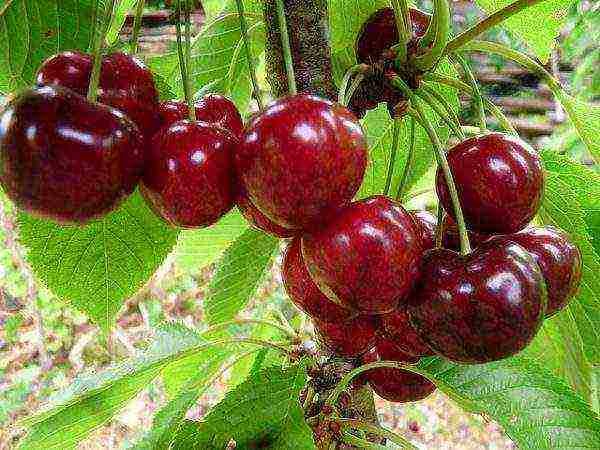
Sweet cherry variety Lapins has every right to be called self-fertile
The fruits are very large, weighing 10 g or more. The shape is round or oval, slightly flattened at the stalk. The skin is colored red, sometimes with a noticeable orange undertone, the flesh is pink-scarlet, dense. The palatability is excellent, estimated at 4.8 points.
The variety does not differ in frost resistance, it also suffers from prolonged droughts. If the summer is rainy, it is more than likely the development of rot and moniliosis, cracking of the berries. There is "innate" immunity from clasterosporia and coccomycosis.
The tree is tall, but it forms new shoots rather reluctantly. The formation of the crown will require considerable effort from the gardener. You can make your task a little easier by grafting Lapins onto a dwarf stock.
Even perfectly ripe berries do not fall from the tree. The variety has good transportability; cherries can be stored in a refrigerator or similar conditions for up to two weeks.
Dolores
The variety is of medium ripening, the fruits are harvested in the second decade of June. Bred in Dagestan. “Parents” - Napoleon black cherry and Lyubskaya cherry. The height of the tree is about 3.5 m, the crown is spreading, dense. But it does not need formative pruning, it is quite sanitary.
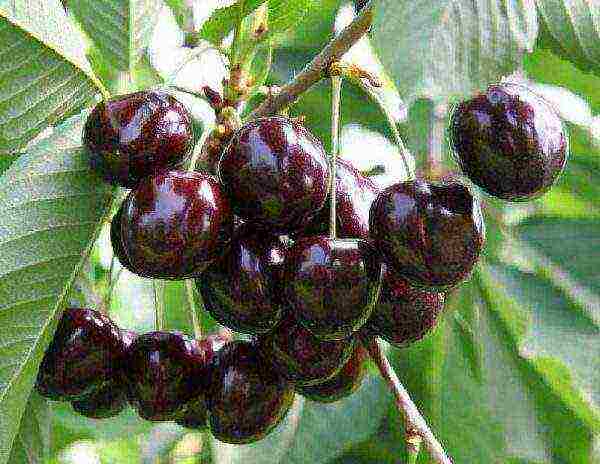
The taste qualities of Dolores cherries are rated as high as possible.
The berries are medium in size (weighing about 6 g), round in shape with pronounced "shoulders" and a side seam. The skin is rather thin, purple-violet, almost black with dark scarlet specks. The pulp is bright red, juicy, literally melts in your mouth. The taste has earned the highest possible assessment from the tasters.
Wood and flower buds are characterized by good frost resistance. Dolores is not particularly affected by droughts. The exception is very intense heat, which, in the absence of rain, can provoke a delay in the growth of the tree and the death of individual shoots. Immunity to fungal diseases is high, with the exception of coccomycosis.
The first fruiting will have to wait 4–5 years. The average yield is 24–32 kg. In the presence of nearby cherries Iput, Revna, this figure increases. Fresh cherries can be stored for 5-7 days.
Sweetheart
Canadian late cherry variety. In North America, one of the most popular for industrial cultivation. Differs in good drought and frost resistance, high transportability. The fruits are harvested at the very end of July or in the first decade of August. A tree of medium height, with a spreading crown. Among the shortcomings, one can note a weak immunity to fungal diseases typical of the culture.

Sweetheart cherry is one of the most popular varieties in North America among professional farmers.
The berries are large, weighing 10–13 g, heart-shaped, but noticeably elongated vertically. The skin is blood-red. The pulp is very sweet, juicy, so tough that it almost crunches. The fruits do not crack even in very rainy weather. Productivity - more than 60 kg per tree.
Bigarro Burlat
An early French sweet cherry variety, known since the beginning of the last century. It is considered the result of natural selection, the "parents" have not been established. The tree is 3–3.5 m high, the crown is in the form of an almost regular ball, thickened. Brownish shoots are dotted with often spaced whitish "lenticels".

It is not yet possible to trace the "pedigree" of the Bigarro Burlat cherry variety
Fruits are medium-sized, weighing 5–6.5 g, slightly flattened in shape. The lateral "seam" stands out clearly. The skin is almost black, the flesh is dark scarlet. The stone is rather large and can be easily separated from it. The berries are tried for the first time 4–5 years after the tree has been planted. In the future, the average yield is 75–80 kg.
Winter hardiness at -20 ° C, this applies to both wood and flower buds. Immunity to pathogenic fungi is good, but it can be better. In cool rainy weather, the fruit tends to crack. The variety is partially self-fertile, in order to increase yields, Exhibition, Napoleon black, Bigarro Starking are planted nearby.
Staccato
Late self-fertile variety of Canadian selection. Ripens in the second decade of August, one of the very last. Natural mutation resulting from free pollination of Sweetheart cherries.
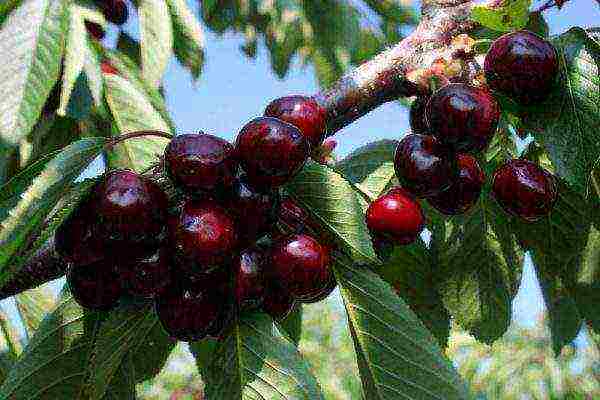
Cherry Staccato is prized by gardeners for its unpretentious care
The berries are large, maroon, weighing 11–12 g, slightly flattened in shape. The skin is firm but thin. The pulp is juicy, very sweet. The taste is rated at 4.8 points out of five. The tree bears fruit for the first time 3-4 years after planting.
Winter hardiness at the level of -25 ° C. The variety is distinguished by undemanding care, the ability to adapt to a wide range of not always favorable climatic and weather conditions, and good immunity.
Thanks to the achievements of modern breeding, sweet cherry is now successfully cultivated in areas with a temperate climate, and the berries are not much inferior in taste to the southern ones. Self-fertile varieties have a number of significant advantages over other varieties. Of course, most of them are not devoid of individual shortcomings, but more often than not they do not spoil the overall picture.
27 years old, higher education in law, broad outlook and interest in a variety of topics. Rate the article:
(2 votes, average: 5 out of 5)

